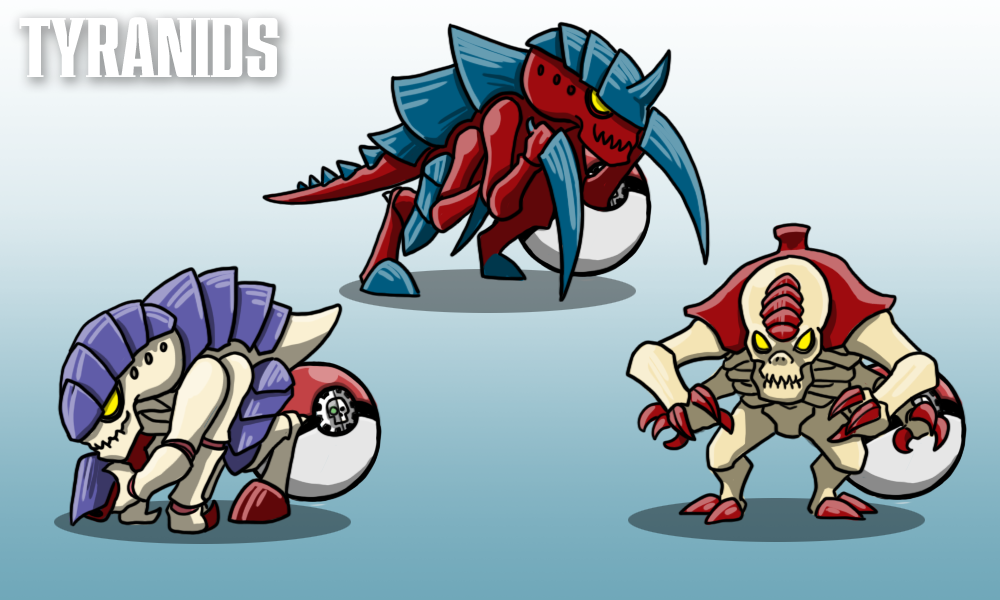Competitively, Tyranids have had a history of suffering, let’s just get that out of the way. Certainly there were a few bright spots along the way, but those were few and far between the decades of lackluster rules that left players with little to work with. We clung to our exceptions, our Hive Guard, our Hive Tyrants, but it was a competitively uninteresting time. With the much-improved 9th edition codex now widely available, Tyranids are enjoying a major resurgence and have become a dominant force toward the top of the various tier charts you’ve no doubt seen across many sites/channels. This, right now, is the best time to be competitively playing Tyranids that we’ve seen in decades. It is a magical time. Let’s make the most of it, shall we?
If you’re new to Tyranids and want to start in competitive play, a beleaguered returning player, or just someone who wants to learn their dirty tricks so they can counter them (not a bad move!), this is going to be where we discuss the Tyranid faction in-depth and break down some of the more successful methods of leveraging the forces of the Hive Mind at peak performance. Most of the general faction abilities and concepts were covered thoroughly in our codex review, but we’re going to briefly review them here as well to make sure there’s no doubts.
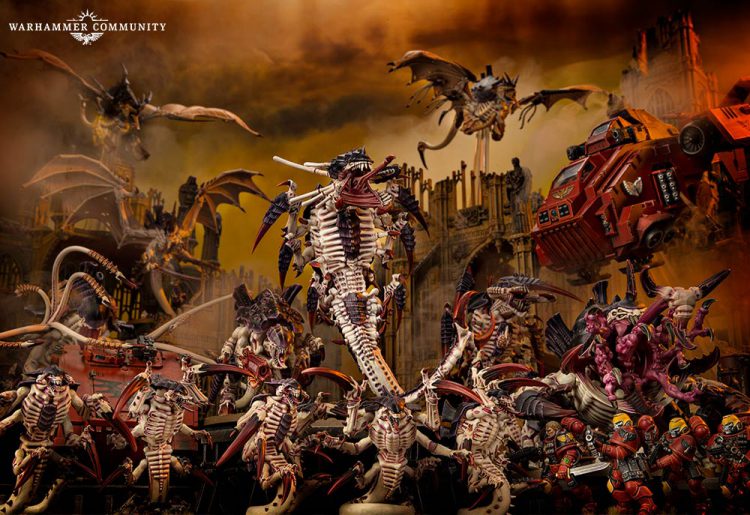
Army Strengths
- Fast, offering multiple options to out-maneuver
- One of the top pysker factions with a great mechanic (Synaptic Link)
- Strong ranged attacks, many with very high damage
- Strong melee attacks, almost any non-horde model is a threat
- Extremely durable, including high toughness units and faction defensive abilities
Army Weaknesses
- Destruction of SYNAPSE units can lead to loss of special abilities*
- Relatively low Ld. score, forcing Leadership checks outside of Morale can cause problems
- High point cost for many units can make for smaller army footprint/board coverage
*That’s been the defining weakness of the faction since their inception, so that’s not really a surprise
Competitive Rating
Strong
Long the butt of many jokes, the current codex has raised the Tyranid faction to a legitimate powerhouse. So much so that the faction has taken a few nerfs across both army rules and point values to reduce their overall power. Even post-nerf, the bugs are still sittin’ well toward the top of the win lists–feel free to take a gander over at 40K Stats if you’re interested in some of the hard numbers.
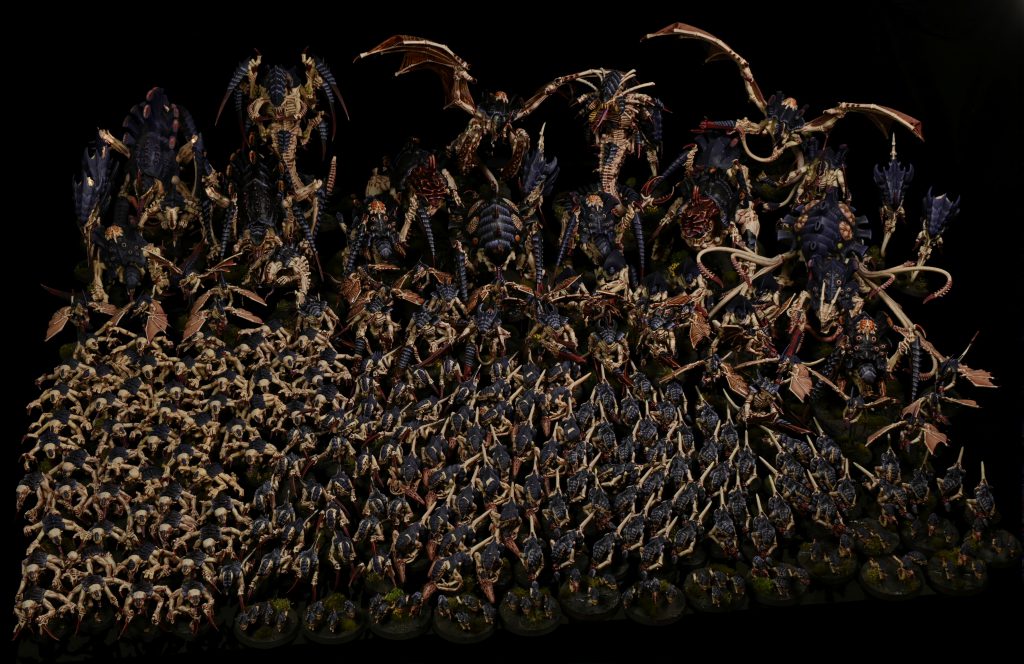
Special Rules
These are the general rules that can apply to many Tyranid units you’re going to see on the table. Death From Below is a bit of an oddball, in that it gets a special mention here but its related ability Death From Above does not. Regardless, these are important rules you’ll want to know offhand to speed up your play.
Synapse (Aura)
HIVE FLEET units within 6″ of a model with this ability automatically pass Morale tests. This is a classic Tyranid rule, though its range has been reduced a bit this edition. Something to note, Synapse was updated post-codex publication to officially be an Aura. This is not in the printed book, but is reflected in the app as well as the FAQ where the change was made. This typically won’t matter, but it does mean that certain abilities that shut down Auras can spell big trouble.
Shadow In The Warp (Aura)
Enemy psykers within 18″ of this unit subtract 1 from Psychic tests and any Perils of the Warp inflicts 1 additional wound. This is a very useful tool, as Tyranids are generally very potent psykers of their own. This means that not only do enemy psychic tests fail more often, but also it is easier to deny any successful attempts.
Swarming Masses
Units with this rule can make attacks during the fight phase if they are in Engagement Range or within 2 1/2″ of enemy units. This is a nice little benefit for horde units, such as Hormagants, as they can get some extra attacking models if they pile in correctly.
Death From Below
These units can be selected to be held in reserve, and can instead be setup outside of 9″ of enemy units in during the Reinforcement step of the Movement phase. This is the traditional “deep strike” mechanic.
Synaptic Link
Synaptic Link is a concept that was introduced within the Warzone Ocarius: Rising Tide supplement and only usable with the Leviathan hive fleet, but was further tuned for 9th edition and is now considered a core concept of the entire army. Essentially, any SYNAPSE unit has a Synaptic Link range of 12″, and that unit can chain any abilities/powers that use Synaptic Link as a range from itself to another SYNAPSE unit to further extend the reach of the power by that units 12″ range.
If utilized correctly, abilities can be chained far across the table, even making psychic powers undeniable by the psyker being outside of 24″ of enemy units. Mastery of this mechanic is going to be very important to ensure your units are properly supported and your opponents units are properly smote/debuffed.
Synaptic Imperatives
An all-new and completely phenomenal game mechanic for 9th edition, Synaptic Imperatives allows Tyranid players to adjust to the state of the game and implement powerful army-wide buffs for the entire game round. To the dismay of Genestealer Cultists everywhere, this mechanic is only accessible if the army consists of only HIVE TENDRIL detachments and only if your detachments include a single choice of HIVE FLEET. This is a huge incentive to field your army as mono-faction mono-Hive Fleet and ditch the old 8th edition style of combining the best of multiple fleets.
Each non-Forgeworld SYNAPSE unit type provides access to a different Synaptic Imperative. These imperatives can only be used once per game* and cannot be used if all models that provide the imperative are destroyed**. Additionally (as of this Tyranid dataslate update), Synaptic Imperatives can only be accessed if your Warlord is alive and on the battlefield. This is a significant change and you’ll need to be mindful of it when selecting and defending your Warlord.
Each imperative you select becomes active at the start of the battle round (even if you’re going second), and lasts until the start of the next round. Some of these abilities are stronger than others and you will likely find yourself reserving some points in your army list for at least one of them. While you can use them in any order you choose, it’s good to look at your battleplan in advance and plot out how things are going to land, as this can inform your actions in advance of the next round.
Each Synaptic Imperative affects any SYNAPSE models in your army that are on the battlefield, as well as non-SYNAPSE units within 6″ of a SYNAPSE model.
*The Leviathan psychic power Hive Nexus allows a single CORE unit access to a different Synaptic Imperative for the turn
**The Stratagem Synaptic Legacy allows you to access/use a Synaptic Imperative from a destroyed unit that has not yet been used during the game
Relentless Ferocity (HIVE TYRANT)
The unit is eligible to charge in a turn in which it Fell Back.
Once the domain of Kraken, now any Hive Fleet can perform this trickery with the assistance of their great leader. Depending on the matchup this imperative may not be critically important, especially as many factions will likely do the falling back to escape you on their own turn, but it can be very helpful to have in your back pocket. Bear in mind that falling back in 9th edition means both no shooting* and no Psychic tests, which might be huge if you’re making a decision to back out a HIVE TYRANT model or other potent melee psyker. B
Note that the models that can use these abilities are based on a KEYWORD, which means both the Swarmlord and Winged Hive Tyrant have access to Relentless Ferocity by virtue of having the HIVE TYRANT keyword.
*The Heightened Reflexes adaptation allows your units to shoot after falling back.
Guidemind (TYRANID PRIME)
Units within SYNAPSE range that target an enemy unit within 24″ with a ranged attack treat unmodified hit rolls of 6 as 2 hits instead of 1.
A good boost to mid-range shooting, especially if re-rolls are involved to fish for better results. Best applied to mass gunline fire mid-game, so if you’re mostly concerned with long range or melee this may not be so helpful. B
Predatory Guile (BROODLORD)
Units are treated as having the benefit of Light Cover, unless they already have Light Cover in which case they additionally have Heavy Cover.
Potential army-wide cover bonus isn’t necessarily a bad thing, as it can really help you on the approach in the early turns or surviving late-game objective contests. The major pain point here is the Broodlord tied to it is going to eat up one of your precious HQ slots and the time for defensive Imperatives likely lies with Warp Shielding. C
Surging Vitality (TERVIGON)
Units add 2″ to any Move or Advance.
For a horde army, this is just a fabulous boon for getting better board coverage and claiming objectives early. That said, a horde army is likely the only times you’re going to see a Tervigon on the table, as it is intrinsically tied to Termagants in large numbers. Other lists are certainly going to find it helpful, but you’ve got a ton of your list tied up in a Tervigon without supporting bugs and what is it doing for you. A for horde lists, C+ for non-horde
Psychic Augmentation (NEUROTHROPE)
Psykers add 1 to Psychic tests and Deny the Witch tests. Models gain a 5+++ against any source of mortal wounds.
A very powerful imperative mid game for a psychic offensive that also grants you some bonus staying power against tricks other factions may use to bypass your defenses. This should allow reliable Psychic tests for a turn, as well as spelling doom for any psyker within 18″ of a SYNAPSE unit as they’ll be burdened with a -2 modifier. A
Thrashing Demise (TRYGON PRIME)
Each time you roll a Death Throes check, add 3 to the result. Any models that are destroyed in melee and do not have the Death Throes ability inflict a mortal wound on a roll of 6.
Your army dies more gloriously? If planned absolutely perfectly, the targeted application of some mortal wounds to enemy models might be a clutch strategic play, but that’s assuming your monsters (which is what have Death Throes) are dying and that’s somehow “all according to plan.” Still fails on a un-re-rollable 1-2, so don’t bet your match on it. D-
Goaded to Slaughter (TYRANID WARRIOR)
Unmodified melee hit rolls of 6 score an additional hit.
This is a solid, if dry, mid-to-late game imperative. Almost every Tyranid army you’re going to see on the table is going to include at least one unit of Tyranid Warriors, so this is going to be a bread and butter imperative you’ll have on hand. B
Psychic Oversight (MALECEPTOR)
Units can perform actions even after advancing or falling back and still make a shooting attack. Psykers can perform a psychic action and still manifest psychic powers.
This can be a critical imperative if you plan to use any action-based secondaries (or the occasional mission with a primary bonus objective). Then again, if your plans do not include any action-based objectives, its not going to be helpful. Maleceptors, even after a number of nerfs, are still considered a potent unit to have in your army and electing to bring one along will likely have you considering picking some actions to perform. B+
Warp Shielding (ZOANTHROPE)
MONSTER models gain a 4+ invulnerable save, non-MONSTER models gain a 5++ save.
This, right here, is THE Synaptic Imperative. All others pale in comparison to the capability to reduce incoming damage for a round by up to 33-50%*. Typically utilized in the first turn unless you or your opponent are playing really cagey, apply this imperative when you’re going to be taking the heaviest fire. Competitively, it’s almost assumed that you’re going to be fielding a unit of Zoanthropes for this every time. The actual unit its tied to is great on its own, but if it was just 150pts for this alone it might still be worth it. It’s that good. Use it. A+
*Obviously the real number here varies heavily depending on the attacks AP value, the models armour save, innate invulnerable save, etc., but big numbers look nice.
Swift Onslaught (PARASITE OF MORTREX)
Models may move an additional 3″ while consolidating (up to 9″).
This is another imperative that’s a bit more helpful for hordes, but as canny players know consolidation moves in the fight phase can be critical to success, even with single large MONSTER models. While its not a must, the Parasite is a handy bug to have around and this is just the gross cherry on top. B
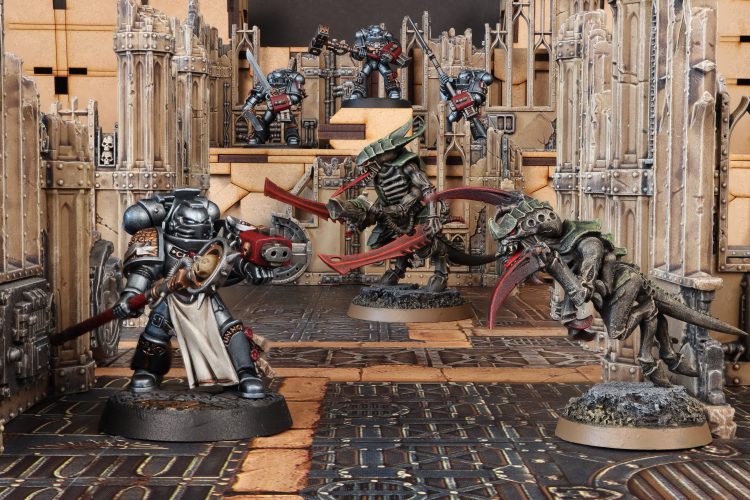
Credit: Pendulin
Detachment Abilities
These rules apply to any detachment that only include HIVE TENDRIL models (excluding UNALIGNED if fortifications are your thing). This section mostly covers some of the housekeeping normal codex stuff.
Rare Organisms
Only one HIVE TYRANT can be included in each HIVE TENDRIL detachment in your army. If your army contains one or more HIVE TYRANT models, one of them must be selected as your WARLORD.
This is an obvious limitation placed on your HIVE TYRANT models because they’re just that good. You can still dip into additional models if you want, but you’re going to have to pay the detachment tax for it and make sure you can fill your slots appropriately. With the recent change to how Synaptic Imperatives are tied to your WARLORD models status, forcing your HIVE TYRANT to take on the mantle means they’ll be an even greater target. Consider if some Tyrant Guard will fit into your army list budget, because they’re very helpful in avoiding some big-time disappointment.
Hive Fleet Adaptations
If all models in a detachment (excluding HIVE TENDRIL LIVING ARTILLERY and UNALIGNED) share the same HIVE FLEET keyword, the units in the detachment gain the Hive Fleet adaptation associated with that Hive Fleet (custom Hive Fleets being an obvious exception).
Hyper-Adaptations
Hyper-Adaptations are a really great idea that, unfortunately, has become extremely non-adaptive in Matched Play since the Q3 2022 Balance Data Slate update. While the rules state that a Hive Fleet can elect to change their default Adaptive trait for one of certain types (again, neat), Tyranid armies participating in Matched Play–thus, all competitive play–must select whether they choose a different Adaptive trait during army construction and not prior to the start of the game. It is disappointing, yes, but many of the Adaptive traits are good (as we will discuss below) and locking them in advance isn’t the end of the world.
Spore Seeding
LIVING ARTILLERY units can be included in a HIVE TENDRIL detachment without breaking Hive Fleet Adaptation or Hyper-Adaptation, though they can never benefit from them themselves.
These rules ensure your spores can be included without any weird questions around breaking detachment rules.
Hive Fleets
Below are the six main Hive Fleets, each of which include a Hive Fleet Adaptation (HFA), a unique Adaptive trait which can be exchanged, as well as a unique Warlord Trait, Relic, and Stratagem.
Adaptive traits can be exchanged for another trait from three trait tables: Feed, Hunt, or Lurk. Each Hive Fleet has two tables specified in their Hyper-adaptation rule, while custom fleets may select one trait from two different tables of their choice. The full list of available Adaptive traits will be discussed after the main Hive Fleets.
Behemoth
HFA: Hyper-aggression – Units gain +1S on the turn they charged, were charged, or performed a Heroic Intervention. This is generally going to be a fantastic trait for improving wound rolls, as it puts lesser infantry into S4 territory and pushes many stronger units over the edge as well (Adrenal Glands Tyranid Warriors with Boneswords wounding T8 on 3+, for example). A
Adaptive trait – Units may re-roll charge rolls. Simple and incredibly useful for an aggressive melee-centric army. There can be arguments to swap for other traits, but unless you’re very lucky or incredibly well-positioned, this will save you a few CP over the course of the battle. B+
Warlord Trait: Monstrous Hunger – An unmodified roll of 6 to wound inflicts a mortal wound in addition to normal damage. It’s not terrible, but the potential damage output from this is minimal compared to the survivability/utility you can get from the other options. C
Psychic Power: Unstoppable Onslaught (WC 7) – One unit within Synaptic Link range adds +1 to wound with melee attacks. Push your hordes to force way more saves or your monsters to wound pretty much anything on a 2+. This is a clear winner if you’re leaning into the whole hyper-aggressive aspect, which you probably should because that’s Behemoths whole schtick. A
Bio-artefact Relic: Monstrous Musculature – Add 1 to the damage characteristic of the bearers melee weapons. While it initially seems good, this is a bit of a miss considering the fantastic generic relics available. If you’re keen on fielding a Trygon Prime this might not be a bad pick; pushing D2 to D3 makes you a bigger threat against the W3 elite models out there and allows you to put hurt on units with damage reduction. C+
Stratagem: Unparalleled Ferocity – A Stratagem that allows slain infantry that has not activated to attack before being removed, costing 1CP for ENDLESS MULTITUDE units and 2CP for anything else. Fight-on-death is definitely something nice to have in your back pocket for the occasion it occurs, though obviously the ideal being you fight first and don’t have to die at all. With the new CP structure beginning in Nephilim, 2CP for this is steep and likely isn’t going to be worth it. Depending on your matchup, most armies will likely want to try to clear your ENDLESS MULTITUDE units in shooting as best they can to avoid this. B-
Behemoth offers a powerful punch for those players that prefer close combat and competitively the fleet sits at the third most popular.
Kraken
HFA: Questing Tendrils – Units that charged improve their armour penetration by 1. This can push many weapons to completely ignore armour saves against many factions, and also helps offset the Armour of Contempt bonus many factions have these days. It’s certainly not the army-wide fall back and charge of old, but it’s not nothing. B+
Adaptive trait – Units making an Advance that do not use Opportunistic Advance or Bounding Advance Stratagems replace their normal Advance roll with 3+d3″. Improved reliability for unit movement is a solid idea, but considering some of the other traits improving the average Advance from 3.5″ to 5″ may not be critical to your success. B-
Warlord Trait: One Step Ahead – If the Warlord is on the table, gain 1CP for any Stratagem used by an opponent on a 5+. This is the only method of farming CP Tyranids have access to and on average is going to net you more returned than you’ll be spending for the trait. Bear in mind, the return on this depends heavily on how frequently your opponent uses Stratagems. If they blow them all in one or two turns, you’re not going to getting as many, but the constant CP-drip in Nephilim helps encourage more moderated spend. Best to place it on a easy-to-hide non-Warlord character such as a Neurothrope using Hive Predator. B
Psychic Power: Synaptic Lure (WC 5) – Allows units to reroll charges against a targeted enemy unit within Synaptic Link range. An easy power to get off that provides a significant benefit to your offensive plays, mitigating for unlucky rolls against a prime target. Combine with Shard Lure if you really need something charged. A
Bio-artefact Relic: Chameleonic Mutation – Any attack against the bearer has its to hit roll reduced by 1 and the hit roll cannot be re-rolled. An incredible enhancement for survivability, this is a prime choice for Winged Hive Tyrants to keep them in the game longer. The only downside is this competes for other great relics for the same unit, though an argument can be made that cool offensive relics aren’t worth anything if your unit is dead before it gets to use them. B
Stratagem: Opportunistic Advance – A Stratagem that allows a unit to advance 8″ and ignore the shooting hit roll penalty for advancing. An incredible Stratagem that provides something in a game of chance you rarely get: a guaranteed result. Powerful for a variety of purposes, including zooming already fast melee monsters into combat in combination with the Onslaught power or opportunistically (see what we did there) snagging an objective in range. A+
Kraken improves the overall speed with its strong unique psychic power, Relic, and Stratagem. Competitively it is the second most popular Hive Fleet.

Leviathan
HFA: Synaptic Control – Wound rolls of 1-3 fail on SYNAPSE units, wound rolls of 1-2 fail on non-SYNAPSE units in Synaptic Link range. This is a huge defensive boon for the Hive Fleet, weakening application of high powered weapons which makes your important SYNAPSE units last. While it is indeed great (and the first reason most players pick the subfaction), bear in mind weapons with strength equal to or less than the toughness of the model are unaffected so you’re still going to be making plenty of saves for successful wound rolls. A+
Adaptive trait – Units may re-roll one hit roll in the shooting and fight phase. A solid general benefit that we see in many factions, this is best applied to units with a small number of very powerful shots (i.e. heavy venom cannons). If you’re not fielding many of those, consider swapping this out for another option. B
Warlord Trait: Perfectly Adapted – The Warlord can re-roll one of the following per battle round: hit, wound, damage, advance, psychic test, saving throw. In a vacuum this is a nice trait, improving the reliability of a critical action, but compared to the other general traits there are better options. C
Psychic Power: Hive Nexus (WC 7) – Allows one CORE unit to benefit from an inactive Synaptic Imperative. This took a bit of a nerf, as it was being abused by Maleceptors, but it is still a really damn good power to have on hand. There are a number of Synaptic Imperatives that are useful at any given time, and being capable of doling them out as-needed (without a reuse limit) is very strong. Indefinitely 5++ Tyranid Warriors, anyone? A
Bio-artefact Relic: Preceptic Node – Allows one CORE or Character unit within 6″ to fire on an enemy unit appearing within 18″ from reserves. The concept is nice, but in execution it is highly situational and pales when compared to the other general relics available. D
Stratagem: Combined Assault – Increases armour penetration by 1 for attacks against an enemy unit that is engaged with two or more Leviathan units. This has potential to be useful as Tyranids have some very high, and some aggressively medium AP values this can be great for pushing you over the line. AP-5 Boneswords on Hive Tyrants guarantee the push through on Armour of Contempt Marines, and raising the AP of small bugs a little can help a lot with getting your opponent off of good saves. B-
Leviathan offers incredible durability for SYNAPSE models that were already tough, and the natural re-roll can assist units that have a small number of high-powered shoots. While the Hive Fleet traits and power are great, the Warlord Trait, Relic, and Stratagem are pretty underwhelming. Regardless, the siren song of Synaptic Control/Hive Nexus makes Leviathan the clear leader in Hive Fleet competitive popularity.
Gorgon
HFA: Adaptive Toxins – Units attacking non-VEHICLE/TITANIC always wound targets on a 4+ (shooting or melee). Good against tougher non-mechanized armies (including Tyranids), but is highly dependent on the matchup. Going into mechanized factions this isn’t going to get you anywhere. B
Adaptive trait – Units can re-roll one wound roll in the shooting and fight phase. A free re-roll is always nice, but re-rolling wounds won’t help you if you don’t hit. Similar to Leviathans trait, works best on small numbers of high-powered attacks. B-
Warlord Trait: Lethal Miasma – The Warlord can inflict mortal wounds to nearby enemy units within 3″, 1 mortal wound on a roll of 2-5 and d3 mortal wounds on a 6. Considering the many sources of mortal wounds the Tyranids are capable of, this isn’t going to be super useful. Depending on the matchup, your Warlord is likely going to end what its targeting and if you’re charging it into multiple units to inflict chip damage they’re likely not long for this world. C-
Psychic Power: Poisonous Influence (WC 7) – One unit in Synaptic Link range causes 6s to wound in melee to inflict an additional mortal wound (up to 6). If you’re going the horde route (which for Gorgon is not a bad choice), this is a great power to drag down larger targets in a sea of shrieking bugs. Loses its best targets as your army starts getting whittled down, but definitely a nice option to have. B+
Bio-artefact Relic: Hypermorphic Biology – The bearer improves their toughness by 1 and doubles wounds for the purpose of bracketing. Great relic for Hive Tyrants of either flavor but is nice on any Character monster. On a walking Hive Tyrant, it’s one of the few instances of T9 in the game. A-
Stratagem: Hyper-toxicity – Causes a TOXIN SACS unit to automatically wound on 5+ to hit. THE Stratagem for a huge block of Hormagaunts, but not really great outside of that ideal scenario. C
Gorgon is a poisonous fleet and it really shows in their bonuses, as it can tear down monsters and tough infantry in a sea of toxic talons but is going to have trouble against mechanized opponents. This is another fleet that really benefits large numbers of infantry and where Devourers might actually find some use (probably not). Competitively, Gorgon sits at sixth out of seven Hive Fleets.
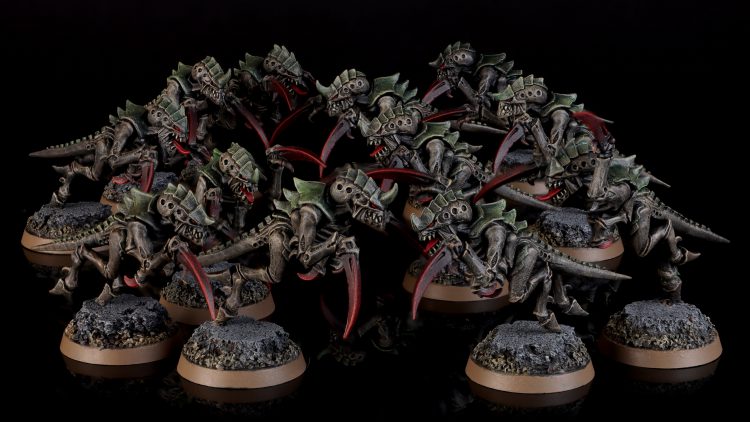
Credit: Pendulin
Jormungandr
HFA: Tunnel Networks – Against enemy ranged attacks, non-MONSTER units 12″+ away and MONSTER units 18″+ away are treated having the benefits of Dense cover. A significant survivability bump for the initial turns as the armies make the approach, but quickly loses its value as the game advances. B
Adaptive trait – Halve the model count for determining Blast weapon hits (11+ for minimum 3 hits, 21+ for flat 3/6). Extremely situational, but in those situations where your 20-count unit is facing down Blast weapons it’s slick. Unless you plan on going full-on horde with your Jormungandr list, you can probably safely plan to drop this en lieu of another option. B for horde lists, F for general lists
Warlord Trait: Insidious Threat – One unit within Synaptic Link range of the bearer can ignore the benefits of cover. Another situational capability for the Hive Fleet, but potentially very helpful in digging out some of the tougher units that can rely on cover for added bonuses. Worth the CP? Probably not. C-
Psychic Power: Lurking Maws (WC 7) – Increase the armour penetration by 1 for any melee attack made by a unit within either Synaptic Link range or 18″. A solid buff for any unit in a critical melee situation and handy to have around. B
Bio-artefact Relic: Infrasonic Roar – The bearer selects one enemy unit within 12″ at the end of the Movement phase, rolls 3d6, and if the result is greater that the enemy units Leadership characteristic that unit cannot perform actions and any in-progress action immediately fails. A neat utility trick but (see the theme here) situational depending on the matchup and secondaries. Placing your relic-bearer in 12″ range of the enemy may not be a great pick if it means danger, but if the bearer has FLY or BURROWER and its critical you can combine Encircle The Prey to duck out after ruining their plans. Unfortunately, most actions worth stopping complete by the end of the players turn. C
Stratagem: Buried in Wait – During the pre-game Declare Reserves step, place any non-TITANIC unit in “deep strike.” This is the party trick that most Jormungandr players are angling for. Obviously the applications of this are very useful, allowing numerous monsters and other units that would otherwise rely on Tyrannocyte or Trygon/Subterranean Assault to appear on the table with ease. It’s great fun but considering the other lackluster aspects of the Hive Fleet, does it make a competitive army? Put enough Carnifex in one squad and it just might. A
A Hive Fleet capable of waiting out the enemy at range while setting up for the strike, Jormungandr offers up some solid survivability and utility, but a lot of the unique aspects here are a bit of a letdown. Being able to combine Buried in Wait and 3 Carnifex for 1CP is a nasty little surprise for mobility and comboed with the Territorial Instincts Adaptive Trait from Lurk which Jormungandr gets access to, there’s definitely power here. Jormungandr is the fourth most popular competitive Hive Fleet.
Kronos
HFA: Bio-Barrage – Add 4″ to the range to any ranged weapons. Simple and useful, Kronos gives you a little more cushion for your gunline. B+
Adaptive trait – Increase the armour penetration by 1 of any ranged attacks within half range. Combines very well with the primary trait, making your gunline bugs comfortable at a distance but also even more deadly if the enemy attempts to close range. B+
Warlord Trait: Soul Hunger (Aura) – The WARLORD has an Aura that forces a Perils of the Warp on any doubles on enemy psychic tests within 18″. Given your the user is likely a SYNAPSE creature this pairs well with Shadow in the Warp, but it’s not especially great compared to generic traits and against non-Psyker armies it will be completely useful. Probably best to leave it. D
Psychic Power: Symbiostorm (WC 7) – Improves the Strength of any ranged weapon by 1 for one unit within Synaptic Link range. A simple buff that many different units can use to great effect. Anywhere the bump is going to take your critical wound rolls into the next category is going to be the obvious choice; various S5 guns into T3 models, S8 into T8, etc. Very useful. A
Bio-artefact Relic: Nullnode – One enemy unit within Synaptic Link range cannot re-roll hits, wounds, or psychic tests until the start of your next turn. A solid debuff against armies that leverage re-rolls to push wounds or against unlucky enemy psykers in tandem with Shadow in the Warp and Deepest Shadow. B-
Stratagem: Deepest Shadow – If an enemy psyker fails a psychic test within 18″ of a KRONOS PSYKER, inflict d3 mortal wounds and until the end of the phase any additional failed tests within that same range also inflict d3 mortal wounds. Against psyker-heavy armies this can potentially be very, very strong if dropped in right location, especially considering Shadow in the Warp and the Psychic Augmentation Synaptic Imperative can take tests to a -2 modifier. This is all well and good, but be mindful of matchups–this is worthless against an army without psykers and if they only have a few it’s not going to be all that impactful. B
If you like shooting the enemy at range, Kronos is your friend. There’s not too much synergy between the shooting and anti-psyker aspects of the fleet, but it does potentially force psychic armies to be more cautious which in turn causes them to get shot more. That said, a lot of Kronos’ tricks expect a psychic opponent and going into armies without psykers you basically have to shelf one half of your army’s unique attributes. Competitively, Kronos is sitting at fifth out of seven for Hive Fleets.
Hydra
HFA: Swarming Instincts – Units that outnumber the enemy models in the fight phase get +1 to hit. Hydra’s whole deal is swarms of bugs and this is a great force multiplier. Against most armies your units should be able to outnumber their targets (perhaps after a handy application of Endless Swarm). Obviously not useful for individual MONSTER units or elite infantry in most cases, but that’s not why you’re here are you? A
Adaptive trait: Add 1″ to unit movement and +3″ to consolidation (up to 9″) in the fight phase. Another great swarming trait; the bonus movement is always going to be helpful generally (especially since you’re liking using adrenal glands already), and the bonus consolidation means that your horde is going to be able to encircle your enemy swiftly. With this, Hormagaunts are piling in 6″ and consolidating 6″ without and buffs or tricks. That’s hugely powerful for repositioning and bullying enemy units off objectives. A
Warlord Trait: Endless Regeneration – At the start of each Command phase, the user regains up to d3 wounds. If you intend to bring a leader-beast along for the ride, this is a serious survival boost. Likely not worthwhile on small HQs if you’re avoiding monsters, but if you’re bringing along a HIVE TYRANT this is definitely something to consider. Doesn’t help you if your WARLORD is blown off the table by heavy fire, but what will. B
Psychic Power: Psychic Shriek (WC 6) – Select one enemy unit either in Synaptic Link range or within 18″ of the PSYKER. Roll a d6 for every HYRDRA INFANTRY within 3″ of the unit and 3d6 for every HYDRA MONSTER within 3″. Every result of 5+ inflicts a mortal wound (up to a maximum of 6). If you’re already swarming an enemy line, this power can go a good way toward tearing down tougher models. It’s a little awkward in terms of how many models you’re actually going to get within 3″ if they’re not engaged, but the Hive Fleet has speed on its side. B+
Bio-artefact Relic: Barbworm Infestation – The bearer may re-roll all wound rolls when making ranged attacks. Considering the limited amount of shooting that a Character capable of using this relic can put out, this is very limited and frankly a bad choice. D
Stratagem: Critical Mass – If the number of models in a HYDRA unit outnumbers the models of an enemy unit, it may re-roll wound rolls. This is a great way to overwhelm durable targets by forcing a ton of saves. It’s especially nice that it does not target an enemy unit in particular, so your unit is engaged with multiple enemies you can opt to split attacks and everything benefits. A
Something to mark here is almost every aspect of Hydras rules are good-to-great yet the Hive Fleet is last in terms of overall usage amongst the seven. Why is that? Firstly, horde armies are quite expensive and take a good amount of hobbying time to assemble/paint. Secondly, even with all the various buffs and tricks horde armies can struggle to put down heavy targets and can be subject to a number of weapons and powers that work well against massed infantry. Yes, Hydra is has nice options, but those nice options apply to arguably the weakest aspect of the Tyranid. That should not stop you from playing the Hive Fleet if that’s your playstyle and it speaks to you, but understand the potential difficulty in competition.
Infinite Biomorphologies
The codex also offers the option to forgo the “traditional” Hive Fleet and make your own out of list of three possible Biomorphologies: Hunt, Lurk, and Feed. The concept is simple, choose a biomorphology from one list to be your Hive Fleet Adaptation, choose one to be your Adaptive trait, and one to be the list you can select from when replacing the Adaptive trait. As noted previously, in Matched Play the Tyranid rules have been updated to force you to select your final trait pre-game, so for the purposes of competition you’re just choosing two.
It’s worth noting here that before the Nephilim Changes, access to the Lurk Biomorphologies were incredibly powerful as they have strong situational effects, especially combined with the Feed options. Since the changes, a Tyranid list is much more inclined to pick a generalist option, which usually means choices from the Hunt Tree, or something built for the list. This is especially important because one of the limiting factors of Kraken and Leviathan previously was their inability to use the Lurk tree, a drawback now diminished.
Hunt Biomorphologies
Adrenalised Onslaught – Units can move up to an additional 3″ during consolidation. Consolidation maneuvering can be critical and extra movement is generally welcomed. As the trait to pick in the Hunt list its in competition with some better options. B-
Heightened Reflexes – Units are eligible to shoot the turn they fell back at a -1 hit modifier. If you’re playing a shooting army this can be a significant benefit, as there are many units that lose a ton of value the moment they’re in close combat (Exocrines are a good example). B
Augmented Ferocity – Units add 1 to charge rolls. Simple and very powerful. Combined with the various abilities to re-roll or further modify charges, this goes a long way to taking the chance out of the Charge phase. A
Synaptic Goading – At the start of the first battle round, ENDLESS MULTITUDE units may make a 6″ move. Good for horde lists, a pre-game move is a way to put early pressure on your opponent or get to better hiding spots if you’re going second. B
Ambush Predators – Units are eligible to perform Heroic Interventions as if they were CHARACTER units. This increases the threat radius of each of your units and makes encroaching on your key positions a much trickier proposition for your opponent. B+
Lurk Biomorphologies
Exoskeletal Reinforcement – Units treat an armour penetration value of -1 as 0 instead. A slight bump in durability, but it is certainly no Armour of Contempt. Probably best to skip it as AP varies so heavily faction-to-faction. D
Naturalised Camouflage – Any time a unit is receiving the benefits of cover, add 1 to any armour saving throw. This is a neat survivability bump, as it doesn’t specify Light Cover only, so Dense also grants the bonus. Obviously you can’t be in cover all the time and its only useful for INFANTRY, BEAST, and SWARM units, so not helpful for a MONSTER-heavy list. B-
Territorial Instincts – MONSTER models have Objective Secured and MONSTER models with 10+ wounds count as 5 models for determining objective control. This is the trait that causes Nidzilla players to forgo normal Hive Fleets. It’s cute, but the most common MONSTER you’re probably going to see stomping around is the noble Carnifex and they can quickly be overwhelmed for control since they only count as a single model. This is a build around trait that can have enormous potential but also does very little for the small stuff. Best in a faction like Jormungandr that can lean a little heavier on monsters. B+
Unfeeling Resilience – Models double the number of wounds remaining for the purposes of bracketing. Not a terrible pick for a non-Carnifex MONSTER-heavy list, but frankly that’s not going to be a terribly common concern and picking traits that only buff a subsection of your list isn’t recommended. C
Synaptic Ganglia – PSYKER units can re-roll failed Deny the Witch tests and also increase the range of any manifested power by 3″. The Tyranid already have a number of anti-Psyker abilities, so this isn’t critical, especially considering a good number of matchups may not have Psykers at all… D
Feed Biomorphologies
Stabilising Membranes – Ranged attacks made by this unit improve their armour penetration by 1 on an unmodified wound roll of 6. Highly situational and overall not that useful. D
Exoskeletal Stabilisation – Models do not suffer hit roll penalty for Advancing or moving and firing a Heavy weapon. MONSTER models do not suffer a hit penalty for firing Heavy weapons in Engagement Range. If you’re fielding horde/elite infantry, advancing and shooting without penalty is great as Tyranid guns are strong and more speed on the table is an obvious win. B+
Wreathed in Shadow – Any time a unit charges, enemy units cannot perform Overwatch or Set to Defend. There are times when ducking strong Overwatch is going to be an obvious benefit, but for those times there is Paroxysm. D
Relentless Hunger – Each time a unit fails a charge it can make a Normal Move of up to 3″. Occasionally useful for grabbing cover and/or getting into Look Out, Sir protection after failing a charge, but it’s just not that helpful. Pro tip: don’t fail your charges. F
Unstoppable Swarm – Units ignore any modifiers to Move characteristic, Advance rolls, and charge rolls. Great for tables with a good spread of Difficult Ground cover but another situational trait whose utility also depends on the matchup. If you’re playing an event where you know there’s a decent amount of difficult terrain and your list struggles with Gheist Storm due to low leadership this may be worth your consideration. Smugly ignoring Photon Grenades, Tanglefoot Grenades and the like would be satisfying, but it’s not a critical trait for an all-comers list. C-
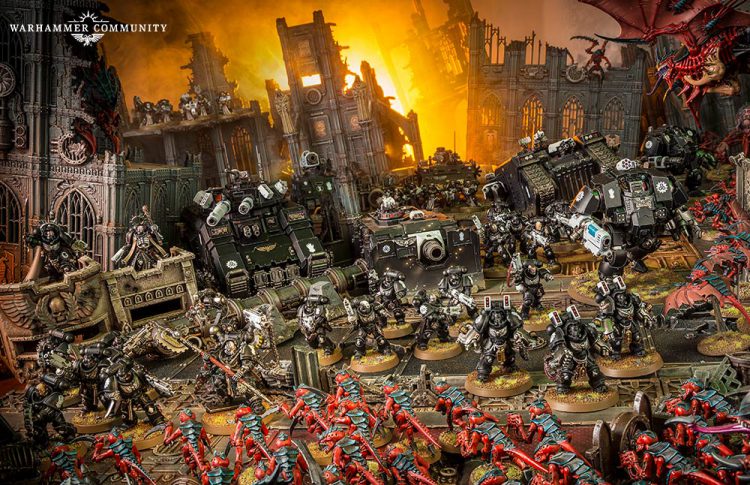
Stratagems
Battle Tactic Stratagems
Scorch Bugs (1CP/2CP) – One unit adds 6″ to the range and 1 to the Strength of Fleshborer or Fleshborer Hive weapons. If the unit has 16+ models or is a MONSTER, the Stratagem costs 2CP instead of 1CP. Fleshborers sitting at S5 means this can be very useful against T3 or T5 models, taking it to wound on a 2+/3+ respectively. That said 2CP is steep for a few more -1AP wounds. C+
Voracious Appetite (1CP) – A MONSTER unit can re-roll wound rolls in melee. A golden classic. Critical for pushing wounds on tougher targets and offsetting applications of Transhuman Physiology or its equivalent. A
Adrenal Surge (1CP/2CP) – An ADRENAL GLANDS unit adds 1 to their number of attacks or d3 to their attacks the unit is a MONSTER. Costs 2CP for 20+ models and 1CP for anything else. Great going into your elite MONSTER units or big blobs of bugs (presumably Hormagaunts), ideally 19 models or less as 2CP is a big spend. Combined with other horde-buffing abilities some Hive Fleets have access to this can be a good force multiplier. A+
Reinforced Hive Node (1CP/2CP) – Reduces the damage characteristic of attacks targeting a TYRANID WARRIOR or TYRANID PRIME unit by 1 for the phase. Tyranid Warriors are very popular for good reason and this is if you have a good number of D2+ attacks coming in. Useful in both the Shooting and Fight phases, against D2/3 attacks it triples/doubles the number of required wounds before killing a Warrior model. A
Observer Organism (1CP) – The shooting attacks of one EXOCRINE unit ignore the benefits of cover and any unmodified hit roll of 6 scores an extra hit. If you’re using one or more Exocrine, this is going to be used frequently. Note that the Exocrine’s Symbiotic Targeting rule already ignores the benefits of cover if it doesn’t move more than half its Movement characteristic, so this is most useful when you have to make a major shift and move the whole 5-8″. B+
Indominable Monstrocity (1CP) – Select a MONSTER unit in any phase. Until the end of the phase, each time an attack is made against that MONSTER an unmodified wound roll of 1-3 always fails. Transhuman Physiology on monsters is an instant win and has obvious applications when dealing with high-powered attacks. A
Epic Deed Stratagems
Power of the Hive Mind (1CP) – One PSYKER CHARACTER (note this was FAQd to disallow Maleceptors) can attempt to manifest one additional psychic power. A great strat to have in your back pocket for those moments where an important target is hanging on with 1W remaining and that spare Smite will do the trick. Also useful to combo with Synaptic Channeling if your units are out of Synaptic Link range and you need to pop something off without impacting the use of the other powers. B
Death Frenzy (2CP) – When a CHARACTER model that has not fought in the Fight phase is destroyed, instead of using any rule triggered (Death Throes) it may fight after the attacking unit is finished. The model is considered at full wounds for the purposes of bracketing. “Fight on death” mechanics are great and a deterrent for opponents concerned about charging their high value targets in. Pricey, but there are definitely times where it’s worth it. B+
Pheromone Trail (1CP) – Select one enemy unit within 6″ of a LICTOR model during the Charge phase. Each time a friendly unit attempts a charge that targets that unit add 2 to the roll result. If you’re fielding a LICTOR (likely Deathleaper), this is a great utility strat you can make some good plays with in the right circumstance. B
Synaptic Channeling (1CP) – During the Psychic phase, select one PSYKER unit in the army. That unit knows all the psychic powers known by all friendly PSYKER units on the battlefield. Hopefully not necessary, but useful in the event your opponent manages to sever your Synaptic Link chain. B
Synaptic Legacy (1CP) – When selecting a Synaptic Imperative at the start of a battle round, if your WARLORD is on the battlefield, you can select a Synaptic Imperative of a destroyed model so long as it has not yet been used that battle. Another contingency strat and one that’s not commonly going to be used unless things are going so downhill that it may not matter anyway. C
Trampling Charge (1CP) – Select a MONSTER in the Charge phase and roll a die. On a 2-4 the enemy unit suffers d3 mortal wounds (3 with HORNED CHITIN) and on a 5+ they suffer 3 mortal wounds (d3+3 with HORNED CHITIN). Great source of mortal wounds in the Charge phase (which matters for things that take a maximum number of wounds a phase) and is almost always worth popping on hard targets. Best on HIVE TYRANT models, as they come stock with HORNED CHITIN. A
Enfolding Strike (1CP) – Use this after a Parasite of Mortex finishes its Move or Advance and moved over any enemy units. Select one enemy non-VEHICLE unit that was moved over and roll a die. On a 2-5 that unit suffers d3 mortal wounds and becomes infected with parasites and on a 6 the unit suffers 3 mortal wounds and is infected. Makes the Parasite even more of a threat/pest and is a great method to strip Objective Secured off without committing to that fight itself. Basically on a 2+ a non-VEHICLE unit is going to suffer at minimum 2d3 mortals before the start of the next Movement phase and for 1CP that’s great. A
Requisition Stratagems
Both of these Stratagems can normally be used once in Combat Patrol and Incursion games, twice in Strike Force games, and three times in Onslaught games.
Rarefied Enhancements (1CP) – Give a Relic to a CHARACTER that is not your WARLORD. Standard codex strat, but there’s a lot of good relics out there. A
Hive Predator (1CP) – Give a Warlord Trait to a CHARACTER. Same deal here, there are great traits and its probably worth a spend here. A
Strategic Ploy Stratagems
Subterranean Assault (1CP) – During the Movement phase when a TRYGON or TRYGON PRIME model is set up on the battlefield, select a Troops unit in Strategic Reserves. That unit may be placed anywhere wholly within 9″ of the TRYGON or TRYGON PRIME and not within 9″ of enemy models. This strat requires heavy investment and the payoff is pretty underwhelming. Deep striking a Troops unit is a nice idea, but when you have to pay the points to place the Troop unit in Strategic Reserves in the first place. D
Rapid Regeneration (1CP) – One model regenerates d3 lost wounds. Great strat, no notes. A
Invisible Hunter (1CP) – At the end of your turn, one LICTOR model can be removed from the battlefield and returned to play in the next Movement phase anywhere within 9″ of the table edge and outside of 9″ of enemy units. Hit and run is now exclusively the domain of LICTOR models, sorry BURROWER and FLY models! A nice option for a model that has served its purpose in its current area and it’s safer/faster to duck out than literally hoof it. B+
Overrun (1CP) – Select one unit at the end of the Fight phase that made a charge this turn. If that unit is no longer in Engagement Range with enemy units that unit can make a Normal Move instead of a consolidation move. Great for potentially escaping danger or snagging cover/an objective. This stratagem is key to one of the most powerful units in the codex, allowing you to constantly deliver and redeliver a Winged Hive Tyrant in and out without risking it, and proper management of this stratagem will win you more games than any other. S
Shard Lure (1CP) – Select one enemy unit that was hit by a ranged attack from a SYNAPSE model in the Shooting phase. Until the end of the turn if that enemy unit is one of the targets of a charge roll, roll one additional d6 and discard one of the dice. Considering the amount of shooting SYNAPSE units can put out, this is a slam dunk and great for mitigating poor rolls. A+
Endless Swarm (1CP) – During the Command phase, select one ENDLESS MULTITUDE unit and return d3+3 models to that unit. These models can be placed in Engagement Range of an enemy unit only if the unit is already in Engagement Range of that unit. If you’re fielding a horde list this is going to be a standard, as its a way to bolster your better units that will be taking fire. Generally useful/good if you have those types of Troops on the table. A
Bounding Advance (1CP/2CP) – During the Movement phase, one unit of HORMAGAUNTS automatically Advances for 6″ and may declare a charge that turn. This costs 1CP unless contains 15+ models, in which case it costs 2CP. If you’re fielding Hormagaunts that is a no-brainer in situations where you need to close the gap. Unless you have a perfectly healthy unit of upgraded ‘gaunts ready to bounce you’re likely sending them to their death, but hopefully they’ll gum up the works for a while. A-
Instinctive Rampage (1CP) – Use this Stratagem in any phase in which a HIVE TYRANT model is destroyed by an enemy unit. Against the unit that destroyed the HIVE TYRANT, each time a TYRANT GUARD unit makes a charge it adds 4 to the charge roll and adds 1 to their attack hit and wound rolls. Not a common problem and not all the helpful, but really a funny concept. C
Encircle The Prey (1CP) – Use this Stratagem at the end of the Movement phase (this was FAQd since publication) and select one BURROWERS or FLY unit and remove that unit from the battlefield. In the Reinforcements step of the next Movement phase, that unit can be returned to the table anywhere more than 9″ away from enemy units. A unit cannot be selected for this Stratagem if it was setup on the battlefield that turn. Good for scoring secondaries or threatening open objectives. B
Spore Clouds (1CP) – In the Movement phase, when a SPORECASTER unit is selected to Remain Stationary. Until the start of the next Command phase, add 6″ to the range of the unit’s aura abilities. Not something you’re commonly going to need unless you’ve somehow overextended yourself in a way that your Venomthropes could stay put. C-
Toxic Entanglement (1CP) – Use this Stratagem in the Shooting phase when a TOXICRENE model from the army scores a hit against an enemy unit (excluding AIRCRAFT) with a ranged attack. Roll a d6; on a 2+ until the start of your next Movement phase half the Movement characteristic of the enemy unit and if they elect to charge they must include the TOXICRENE model as a target. If that TOXICRENE model declares a charge, that enemy unit must be a target and adds 2 to the charge roll result. A really cool and cinematic strat that is almost never going to see use because Toxicrenes aren’t all that competitive. D
Wargear Stratagems
Impaling Hooks (1CP) – In the Fight phase, select a FLESH HOOKS unit. Any melee attacks by that unit that do not target a VEHICLE or MONSTER unit add 1 to their hit roll. Not terrible, but points are precious and there are better sources of hit bonuses/re-rolls. C
Psychotropic Venom (1CP) – In the Morale phase, select one non-VEHICLE enemy unit in Engagement Range of a LASH WHIP or TOXIC LASHES unit. That enemy unit subtracts 2 from its Leadership characteristic and subtracts 1 from Combat Attrition tests. If you’ve put some hurt into an enemy unit with lash-havers and want to force greater losses (especially on large units), that has some potential. B
Acidic Torrent (1CP) – Use this Stratagem in the Fight phase on an ACID MAW unit in Engagement Range with an enemy unit. For each ACID MAW INFANTRY model roll one d6, for each 3+ the enemy unit suffers 1 mortal wound. If this is an ACID MAW MONSTER, roll 3d6 instead. This is not worth your while. D-
Corrosive Viscera (2CP) – Use this Stratagem in the Fight phase when an ACID BLOOD unit would lose a wound. Until the end of the phase for each wound lost by the unit roll one d6. On a 4+, the attacking models unit suffers 1 mortal wound after making all its attacks. This is incredibly expensive for a very underwhelming result unless you’re fielding full units of Pyrovores and they get completely wiped in a turn. D- unless you have 3-model units of Pyrovores where it will frequently be better than an interrupt
Blinding Venom (1CP) – Use this Stratagem in the Fight phase, select one enemy unit in Engagement Range of any GARGOYLES unit. Until the end of the phase, that enemy unit subtracts 1 from its hit rolls and hit rolls cannot be re-rolled. In a pinch this is nice survivability bump but at the end of the day your T3 Sv6 models are probably going to die. B-
Pathogenic Slime (1CP/2CP) – Select a unit, unmodified hit rolls of 6 for ranged attacks automatically wound the target. This costs 1CP if the unit has TOXIN SACS and 2CP if it does not. There’s almost no chance you’re going to have TOXIN SACS on something with a ton of shooting and this is too expensive if you don’t. D
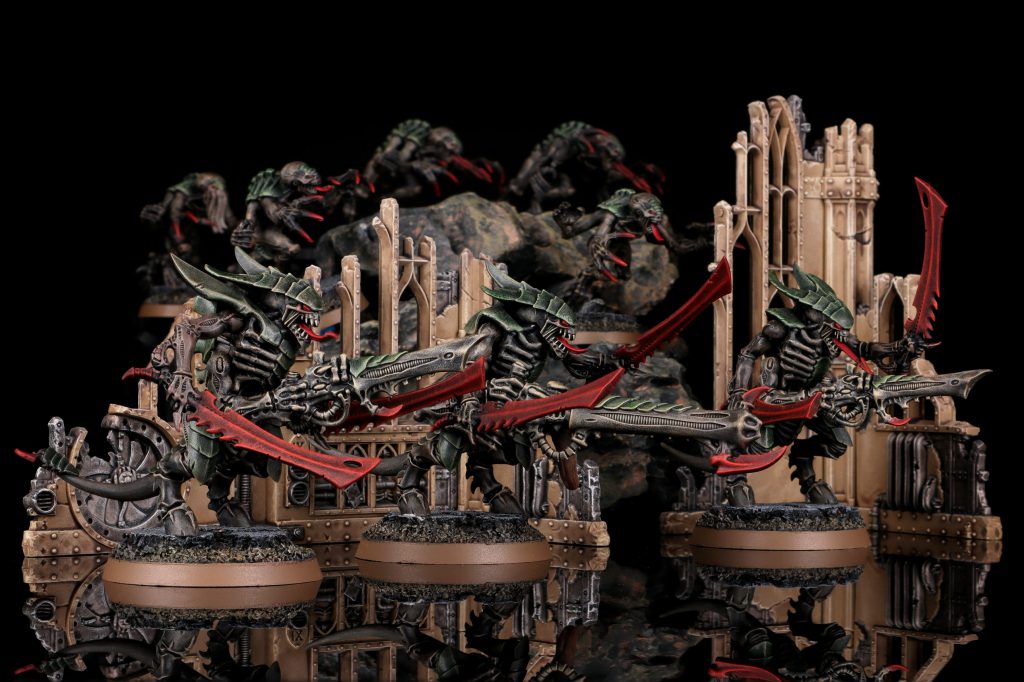
Adaptive Physiologies
Dermic Symbiosis – The model has a 4+ invulnerable. Very simple but it cannot be overstated how good this is on larger MONSTER models that don’t have an invulnerable save to start with. A
Enraged Reserves – The model doubles its wounds for the purposes of bracketing and once per game can use an Epic Deed Stratagem for free. This was FAQd to make it far less useful for a Maleceptor and frankly for its cost it’s not really worth it elsewhere. C
Hardened Biology – Any attacks with a Damage characteristic of 1 is allocated, add 1 to any armour saving throw. There are not going to be many matchups where your MONSTER models are under serious threat from D1 weapons. C
Precognitive Sensoria – The model can fight first in the Fight phase. Fighting first is nice but with the speed of Tyranid and abilities to Fall Back and charge again its value is reduced. B-
Predator Instincts – The model can perform a Heroic Intervention within 6″ horizontally and 5″ vertically. Applied to speedier MONSTER models this can be very useful, especially for staking out an objective since you can guarantee they will make it to combat with any enemy units that try to toe-in. B
Synaptic Enhancement – The model gains the Shadow in the Warp special rule and SYNAPSE keyword. Great for extending your Synaptic Link chain and handing out imperatives at better range. Especially good on Harpies against factions with psychic units, as you can ram some Shadow down their throat early. This will notably also give you 1-3 fails to wound as Leviathan. A+
Voracious Ammunition – Each time the model shoots, select one unit that was hit by at least one attack. Roll one d6 and on a 2+ the unit suffers d3 mortal wounds. If you have the spare points and are fielding gun-beasts, this is a solid option. B-
Whipcoil Reflexes – If an enemy unit attempts to fall back from this model, roll one d6. On a 2+ the enemy unit suffers d3 mortal wounds. Probably not worth it, unless you’re managing to cram the model into an entire Tau gunline or something. C-
Warlord Traits
Alien Cunning – The WARLORD gains Objective Secured, counts as 5 models for determining objective control, and can perform actions if it Advanced or Fell Back. Great for faster units that can harass enemy units and potentially steal objectives/perform secondaries. Best applied on either the Parasite of Mortex or Deathleaper (which can only take this trait). A
Heightened Senses – The WARLORD can fight first in the fight phase and can re-roll hit rolls. Hoenstly not a bad buff, but it competes with better traits. B
Synaptic Lynchpin – The WARLORD increases any Aura ranges and Command phase abilities that specify range by 3″. Very minor improvement and not worth your time. D
Direct Guidance – In the Command phase, one CORE unit within Synaptic Link range of the WARLORD adds 1 to hit rolls until the start of your next Command phase. Simple and powerful if you’re fielding large blocks of Tyranid Warriors or horde units, but also not bad on a CARNIFEX model in a pinch. A-
Synaptic Tendrils – In your Command phase, if your WARLORD has one of the following abilities it can use it twice: Alpha Warrior, Bio-impulses, Brood Pregenitor, Vicious Insight, Warp Siphon, Will of the Hive Mind. Doubling up on some of the better abilities can be very useful and the big winner here is a Neurothrope, where two Warp Siphon‘d units can much more reliably succeed in their Psychic Powers and inflict a “super” Smite. A
Adaptive Biology – Your WARLORD has a 5+ feel no pain. If you’re looking for durability over utility, this is not a bad choice on MONSTER units, especially the “less tough” Winged Hive Tyrant. Allows you to focus your Catalyst on a secondary unit. B+
Hive Mind Discipline
Catalyst (WC 6) – One friendly unit within Synaptic Link range gains 5+ feel no pain until the start of the next Psychic phase. If the unit is TITANIC, it’s a 6 instead. Basic and powerful, Catalyst continues to be a mainstay of the Tyranid powers. A
The Horror (WC 5) – One enemy unit either within 24″ or Synaptic Link range subtracts 2 from their Leadership characteristic and 1 from Combat Attrition tests until the start of the next Psychic phase. Great for breaking the back of large blocks forced to take a morale check. In combination with other abilities such as Psychotropic Venom, you can get attrition to a 50/50 roll. Not always applicable and likely one of the powers that’s not going to make the cut if you don’t have many powers to choose from. B-
Neuroparasite (WC 7) – Roll a dice for every enemy model from a unit either within 18″ or within Synaptic Link range. For every result that exceeds the models Toughness characteristic the unit suffers 1 mortal wound (maximum 6). Good for forcing through mortals on lower Toughness models with good durability, but scales poorly into higher T models. B
Onslaught (WC 6) – One unit within Synaptic Link range does not suffer the hit penalty from Advancing and is eligible to declare a charge if it Advanced. Fantastic utility power and critical to have in your Psychic arsenal if you plan on making charges at any time. A+
Paroxysm (WC 7) – One enemy unit either within 18″ or Synaptic Link range cannot Overwatch or Set to Defend and subtracts 1 from any melee attack wound rolls. A useful power to have on hand (or claw? talon?) if your opponent has a mass of auto-hitting weapons for Overwatch or a strong melee unit you’d like to knock down a peg. It’s a bit difficult to get off but can be huge for survivability against appropriate targets. B+
Psychic Scream (WC 5) – An enemy unit within 18″ suffers d3 mortal wounds and if that unit is a PSYKER and the roll result exceeds the units Leadership score the unit losses access to one psychic power randomly for the rest of the battle. Typically used to just force some extra wounds as a cheap “second” Smite. The random power loss is generally not going to be a thing and planning on it for any reason is just inviting disappointment. B
Relics
The Yrmgarl Factor – At the start of the Fight phase, the bearer can do one of the following: add 2 to Strength, add 1 to Attacks, or add 1 to Toughness. This is a relic they’ve been trying to make work for multiple editions and it’s just still not there. C-
The Reaper of Obliterax – So long as the bearer is a model equipped with bonesword or monstrous bonesword, each time the model successfully wounds a target (regardless of whether it makes a save against that wound roll) the target suffers 1 mortal wound. Enemy models cannot use any rules to ignore the wounds it loses. An offensive powerhouse in the hands of a HIVE TYRANT, pushing mortals into tougher targets and bypassing feel no pain rolls. This relic is a reasonable candidate for best in the Game and allows Tyranids to deal massive non-interactable damage even when the target rolls high on saves. S
The Maw-Claws of Thyrax – The bearer adds 1 to its Attacks, can re-roll melee wound rolls, and if the bearer destroys an enemy unit they permanently increase their Attack by 1 (max +3) until the end of the battle. Not a terrible choice, but it gets out-shone by the Reaper in most cases. It is very handy for Tervigons and cute on a Trygon Prime, though. A-
Resonance Barb – If the bearer is a PSYKER it adds 1 to Psychic tests and knows one additional psychic power. Note this doesn’t allow you to manifest an extra power, just know another one. A solid buff on a Neurothrope for a +2 bonus to any Psychic test. B
Pathogenesis – The bearer adds 8″ to any ranged attacks and each time it shoots it can re-roll one hit roll and one wound roll. Makes a Heavy Venom Cannon HIVE TYRANT much more reliable, but is another Relic that is outshone by its offensive counterpart, Shardgullet. B-
Scythes of Tyran – Replaces the bearers 2 monstrous scything talons with a weapon that adds +2S, -1AP, +1D, and +2A. Note that the +2A only offsets the loss of the normal +2A from the pair of talons and does not improve attacks. Ever wanted to hit slightly less hard than a monstrous bonesword but get a few more attacks? No? Hmm, fine. C-
Balethorn Cannon – Replaces the bearers stranglethorn cannon with a weapon that adds +2S, -1AP, and +1D. Honestly not terrible if you’re looking for an anti-elite Blast weapon but there’s already a good amount of D3+ guns out there and this isn’t likely to make the cut. B-
Shardgullet – Replaces the bearers heavy venom cannon with a weapon that adds +3S, -1AP, and +1D. A very powerful gun that is great at knocking out high-end elite infantry and putting a big hurt on hard targets. If you’re fielding a HVC on a HIVE TYRANT somewhere, this is not a bad call. A-
Gestation Sac – Allows the bearer to perform an action in the Shooting phase to spawn d3+1 Ripper Swarms within 3″ of itself and not in Engagement Range at the end of the phase. A sneaky way to drop some models onto an objective before leaving for a charge, increases models to outnumber your opponent, or potentially score Engage on All Fronts when you would otherwise not. B
The Dirgeheart of Kharis – Select one enemy unit hit by the bearer in the Fight phase, that unit loses Objective Secured and subtracts 1 from its Leadership characteristic. Has the potential to be clutch in a specific scenario, but paying out 1CP each game until its time comes is not worth it. C-
The Passenger – An ADRENAL GLANDS bearer adds 2 to both Advance and charge rolls. Potentially great for putting pressure on an opponent with a speedy assault, especially with the large number of ways to further modify your charge roll. Unfortunately the big candidates for this will be wanting one of the other Relics most of the time and the aforementioned charge buffs mean its effect isn’t ultimately that special. B-
Searhive – If a TOXIN SACS bearer scores any hits in the Fight phase, those hits automatically wound. Fun on units with a high number of attacks such as the TRYGON PRIME, that said most competitive players aren’t going to field a Trygon and this stands in the shadow of greatness. C
Secondary Objectives
No Mercy, No Respite: Synaptic Insight – Each battle round, keep a tally of what models are destroyed by SYNAPSE models if your army. If the SYNAPSE models destroy a model with 3-5Ws tally 1 point, 6-9W tally 2 points, and 10+W tally 3 points. For each round you tally at least 4 points, score 3VP. The codex offers many powerful SYNAPSE models, but considering it doesn’t account for 1-2W models this ignores a TON of infantry that you’re going to see on the field. Canny players will also try to screen out/hide elite models from targeting just to deny you on it. Considering how difficult it might be score, it also weirdly caps at 12. C
Purge The Enemy: Cranial Feasting – Each time an enemy CHARACTER or Unit Champion is destroyed by a model in melee, roll one d6 and add 2 to the result if the attack was made by a model with FEEDER TENDRILS and/or if the enemy model was a CHARACTER. On a 6+, gain 1CP. At the end of the battle, score 1VP for Unit Champions destroyed, score 3VP for CHARACTER destroyed, score 3VP if the enemy WARLORD was destroyed by a model with FEEDER TENDRILS, and score 3VP if at least 1CP was gained during the battle. This is a very complicated and potentially slightly better Assassinate if your list is very melee-centric. Before selecting secondaries, assume you’re going to flub any rolls to get a CP and mentally determine if this is worth it against your opponents list. It’s not a clear winner and is awkward, but there are going to be times where this is going to be the pick. B+
Shadow Operations: Spore Nodes – Starting at the second battle round, at the end of the Movement phase your Troops units can perform an action anywhere within 6″ of the enemy Deployment Zone and not within 6″ of another Spore Node marker. If the action completes, place a Spore Node marker within 1″ of the unit. Score 4VP at the end of the battle each time a marker is placed. If you’re running fast Troops, this is a solid pick against matchups with poor mobility. Screening is a standard practice, but it’s going to be very difficult to screen 6″ out of the Deployment Zone. Gargoyles dropping in via Encircle the Prey are great for this provided you find a hole, as it forces them to deal with it or you just run away with the objective. So long as you bring a number of Troops along this is great, but most lists are going to push for big Warrior blobs over the other Troops options and unless you’re using the Psychic Oversight Imperative losing a turn of Warrior shooting is a rough trade. B
The Units
HQs
Winged Hive Tyrant
Winged Hive Tyrants continue their grand tradition of being a complete terror, coming stock with a number of strong weapon options and access to two psychic powers and one denial. Thankfully for the other factions GW has limited access to HIVE TYRANT models to one per detachment, so double-dipping on these powerhouses is going to eat into your CP budget substantially (though they’re so good you may want to anyway). These lithe winged beasts are fast enough to give you some tactical flexibility at the trade off of being slightly less tough than their walking counterparts. Many of the Warlord Traits and Relics discussed above pair very well here, the most common being the Adaptive Biology for Warlord Trait and Reaper of Obliterax for Relic. Many of the other combinations are valid but this increases its offensive threat and offers additional longevity, which you are going to need because it’s going to be a high priority target.
Something new for this edition is the fact that Winged Hive Tyrants do not have two “weapon slots”, so there’s no more combining melee weapon options and shooting options. If you opt for a ranged weapon, you are severely limiting your melee punch but this may be just fine if you’re opting for a long-range support platform that lurks in the distance menacingly. This can also make defending your HQ easier, as Tyrant Guard are very beneficial for HIVE TYRANTS that want to hang back (or at least keep pace with their legged bodyguard). That said, on the competitive front most Winged Hive Tyrants are looking to get into melee combat with the right target as quickly as possible.

From a Hive Fleet perspective, Winged Hive Tyrants benefit substantially from Leviathan’s Synaptic Control adaptation, as their T7 stat is inviting every meltagun and other S8+ weapon their direction. Kraken is also a solid pick if you’re looking for go on the melee offensive; with a little SYNAPSE maneuvering, use Opportunistic Advance for a blindly fast 24+” move and cast Onslaught from more than 24″ away from enemy pyskers across the Synaptic Link chain to make an undeniable charge (re-rollable if you want to get a cast of Synaptic Lure off). If you’re matched against tougher targets, Behemoth monstrous bonesword Tyrants wounding T6+ on 2+s with a cast of Unstoppable Onslaught is great.
The short version is you pretty much can’t go wrong with a Winged Hive Tyrant competitively. The usual competitive build is going to have Adrenal Glands and monstrous bonesword, with or without the Reaper upgrade (and it should be with).
Hive Tyrant
A lot of what was discussed above for Winged Hive Tyrants applies here. The biggest difference is that the speed of this model pairs better with Tyrant Guard (which you will want to give Look Out, Sir) and it’s a better platform for a long range weapon, as the lack of wings gives you an arm socket for a monstrous melee weapon. Competitively, many “walkrants” get kitted with Shardgullet and depending on the overall list are not a terrible place for Direct Guidance since it’s going to be more in the thick of the army and there’s a fair chance it will stick around longer than its flying friend.
The Swarmlord
Now no longer mandatory in a competitive match, the Swarmlord offers increased tactical flexibility including a “commander” full re-roll and the ability to make one CORE unit Objective Secured or count as double models if it already is. Swarmie also gets an extra deny, because its brain is so smart. As always this model is most comfortable in melee, preferably with mid-sized elite models where its D3 swords are going to do the most good. This model is much tougher than its previous version (like the normal Hive Tyrant), but lost its incredible melee 3++ for a “normal” 4++ and the ability to ignore the damage from the first failed save of the turn. This is still not terrible, but the weight of failed saves is going to come down on it harder than it used to and wise opponents are going to try to force small damage first to push through the bigger hits once it can no longer ignore them.
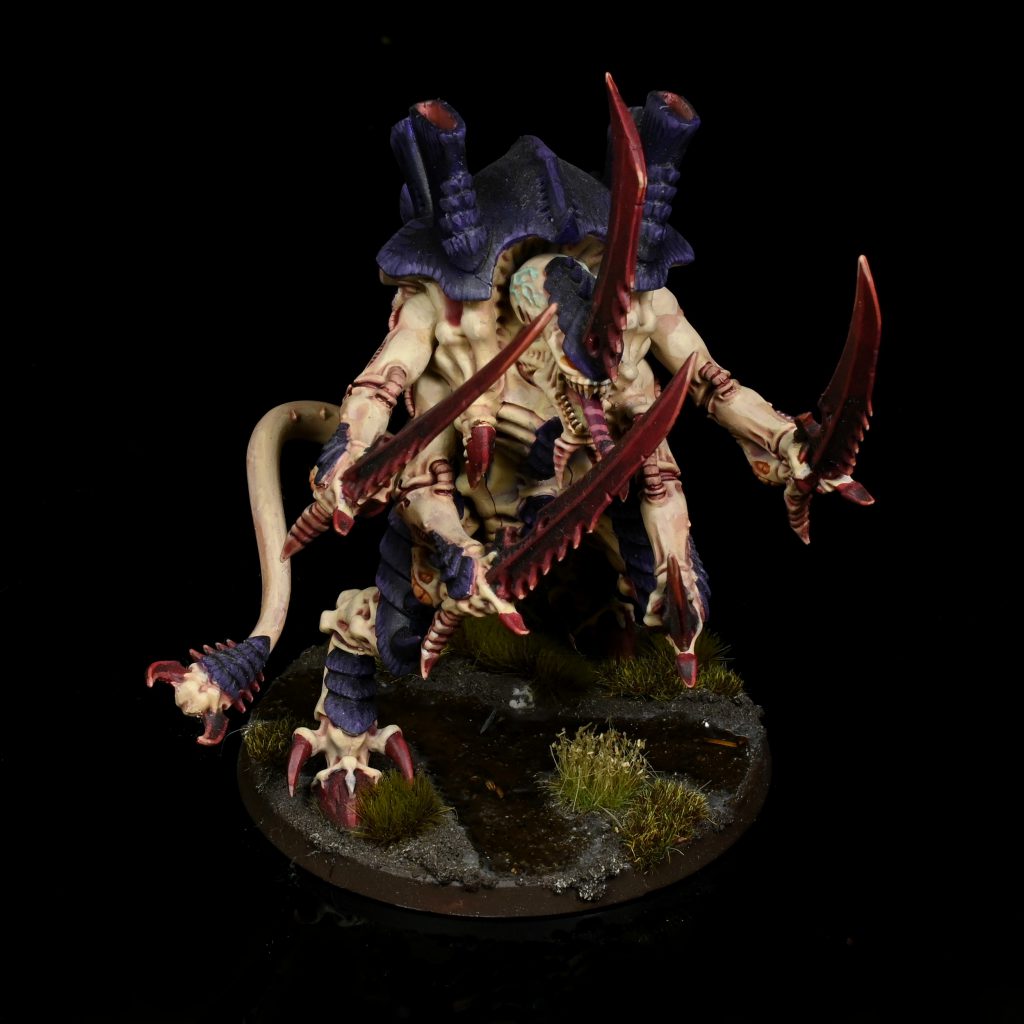
Competitively, the Swarmlord is seen the least of its HIVE TYRANT brethren as it lacks the capability to use the great Warlord Traits (aside from the stinker Synaptic Lynchpin) and Relics, the speed of wings, or strong shooting options. It’s not bad, per se, it’s a unique support HQ and a very scary prospect for a counter-charge, but that the other options are easier to use and better in many situations. There may be an increase in use here as time goes on into the new Nephilim era of paying for Warlord Traits and Relics, but it’ll be a while before we see any clear result.
Broodlord
Broodlords are okay if you’re going to lean into Genestealers and use them as a distraction or mid-weight counter-charge. Forward-deploying along with a bunch of other vicious melee models can be effective in a number of matchups, but swings pretty heavily based on turn order and if it doesn’t work out that’s a lot of points in one basket. Its Synaptic Imperative is a nice-to-have, but not critical for most lists. It does have a good number of attacks and the wound re-rolls help, though their D2 claws really suffer into damage reduction. The real problem here is that they don’t have a direct roll in enhancing Genestealers like they have in previous editions (save for a pretty minor buff via Vicious Insight) and they’re a “good” HQ surrounded by “great” alternatives.
Neurothrope
Surprisingly cheap for how effective it is, the Neurothrope is best support character the Tyranid have. Provided you’re using psykers (which, if you’re playing Tyranids is a good likelihood) the models Warp Siphon ability is great on anything, but especially Zoanthropes where it puts a “super” Smite into near-certainty and Maleceptors where it assists hitting that magical Psychic test target. It’s got a natural bonus to perform Pyschic tests on its own, provides one of the stronger Synaptic Imperatives, is a good platform for support Warlord Traits and Relics, is very durable thanks to the lone 3++ in the codex, and can keep itself or a unit of Zoanthropes topped off with Spirit Leech. Just a steal for the points cost; probably an auto-take in most circumstances.
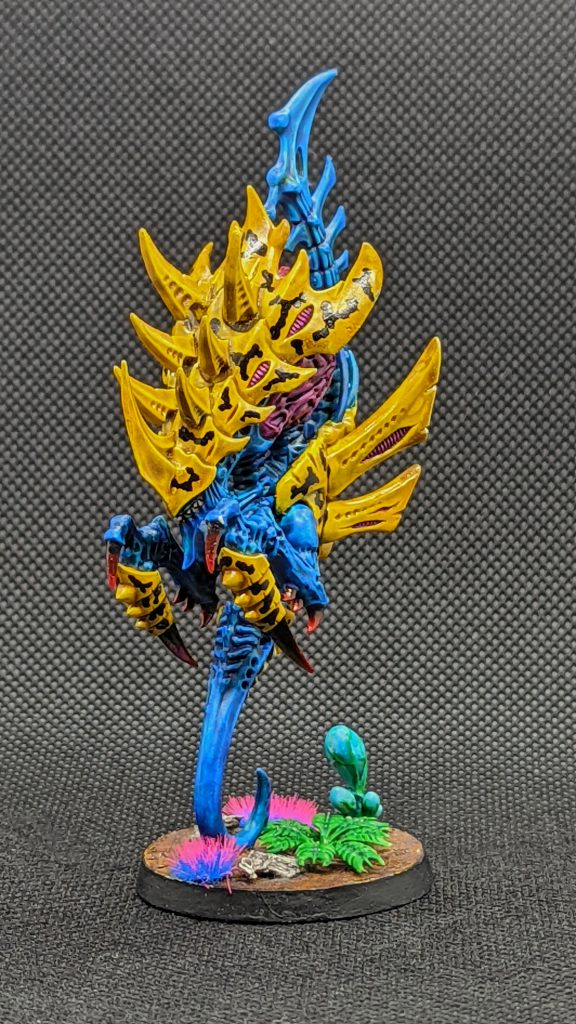
Tyranid Prime
Now the Hive Fleet equivalent of a Space Marine Lieutenant, the Tyranid Prime is potentially a free slot so long as you’re fielding a unit of Warriors as well. Compared to the cost of a normal Warrior they’re probably slightly overcosted for what they bring to the table, unless you’re fielding a gunline in which case their Guidemind Imperative is very useful and probably worth considering.
Tervigon
If you’re considering fielding a horde, consider the Tervigon. It allows you to replenish your Termagants, grant a +1 hit bonus to a TERMAGANT unit, and its Surging Vitality Imperative can make a big different in board control. Its ability to hide itself behind larger Termagant units and its T/Sv make it very durable. It’s certainly not for every list, as its offensive output is comparatively middling for its overall cost, but it’s a must if you want to flood your opponents with bugs. Notable for being one of the best holders of Relic weapons outside of a HIVE TYRANT, Maw-claws of Thyrax and Heightened Senses can provide a high measure of consistency on a monster that can be very difficult to interact with in the right circumstances. One to watch as Tyranid lists evolve.
Trygon Prime
This is a unit we want to like but can’t. To put it bluntly, Trygon Primes are in that awkward place where they’re just not durable enough for their cost. Without an invulnerable save and unable to be hidden with Look Out, Sir they’re just begging to eat the first available round of melta shots and die a sad death. Yes, you can hide them underground, but the moment it springs up it’s in pretty serious danger. Its Bio-impulses support ability is nice, but the Thrashing Demise Imperative is hot garbage so there’s little incentive to bring this thing out to play. If the large number of attacks impresses you, field a Screamer-Killer instead.
Old One Eye
Provided you keep it hidden by other models on the approach, Old One Eye is a terribly dangerous monster on the table. It has a very high damage output and depending on how your overall list is structured your opponent may have trouble chewing through its protective models before it smashes into their lines. As one might expect, OOE is probably best combined with at least a few other CARNIFEX models to hand out a +1 hit modifier (which works for all hits, so this is a nice bump to HVC Carnifex). If you’re looking for a brawler, so long as it closes distance it can cleave through elite infantry and vehicles alike. OOE is expensive points-wise which might cause it to be passed over for a HIVE TYRANT, but the Nephilim Changes may have carved out a niche for Old One Eye due to the painful detachment tax on a second Hive Tyrant.
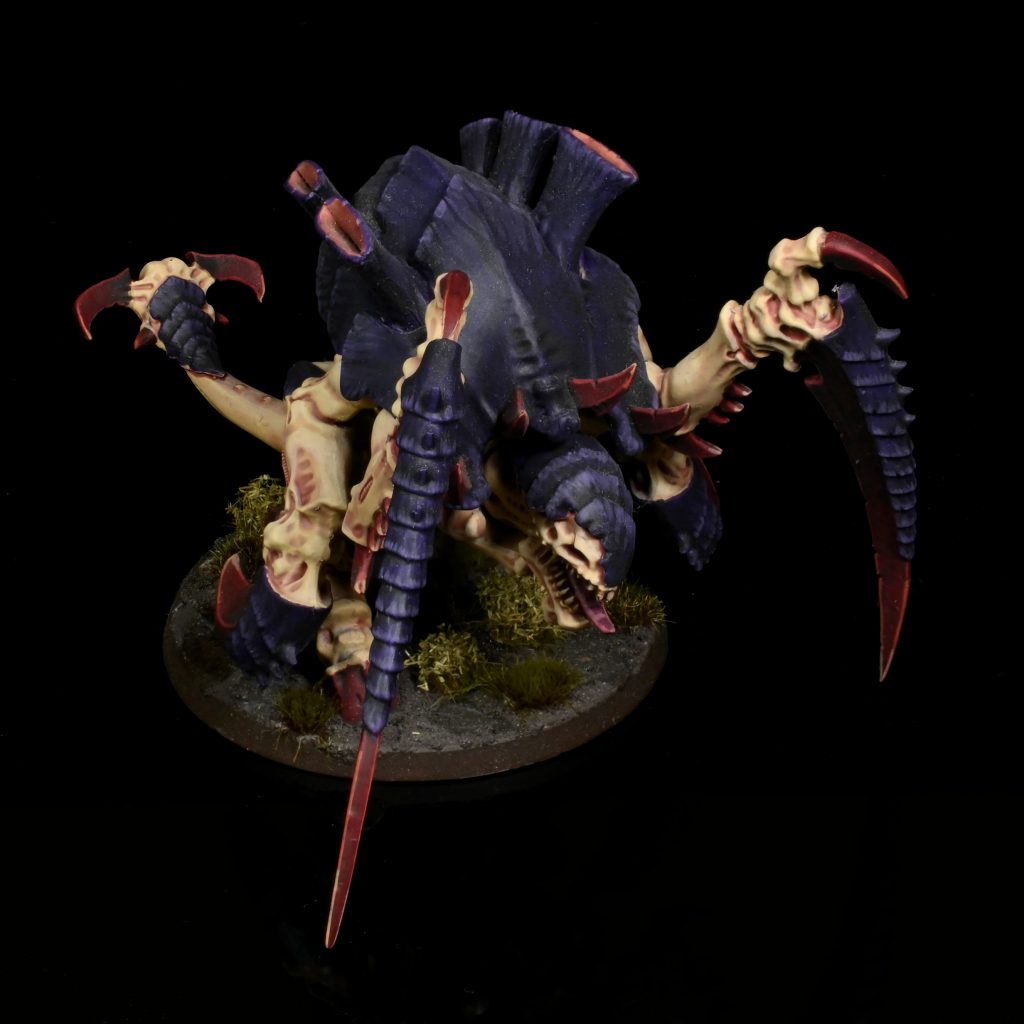
Malanthrope (Forgeworld)
The Malanthrope is tradeoff with Venomthropes, limiting your spore cloud range to within 6″ of a single CHARACTER model that is easy to hide and at W9 tough to chew through. Offensively, you’re not going to get much for your points, as it has “old” Tyranid weapon skill and a limited number of attacks. More expensive than an MSU of Venomthropes, the model itself is really cool but at the moment its overcosted for what it brings to the table.
Troops
Tyranid Warrior
Brutally efficient, Tyranid Warriors are the competitive bread and butter of most Tyranid lists. These models are tough and have high ranged and melee damage output for the cost. There are also a number of defensive buffs that make them a pain to shift, such as Reinforced Hive Node and are a natural fit in Leviathan lists where their SYNAPSE keyword provides them extra durability. Adrenal glands are costed super aggressively here and become a better upgrade as the unit size increases, but it’s basically an auto-take regardless of what size you go for. Competitively these are almost always equipped with dual boneswords and deathspitters, along with however many venom cannons fit in the unit. Not only are venom cannons useful as anti-infantry generally, but it provides a good throwaway long-range attack to tag an enemy unit for Shard Lure.
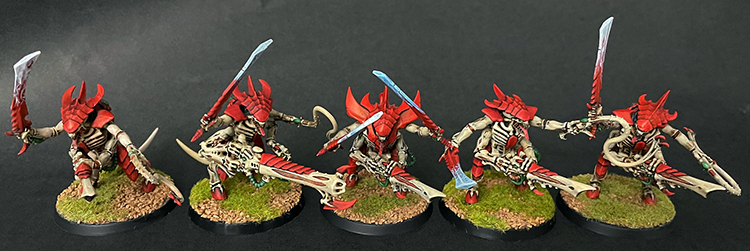
Typically there’s two methods to the unit size here: five or the full nine. The reason here is two-fold, as a five-model unit is under the limit to grant Blast attack bonuses and is the maximum number of models where Reinforced Hive Node is costed at 1CP. The full 9-model unit has its advantages too (and is more popular overall), as the break for venom cannons is one per three models so you get three of them instead of one and unit buffs apply to more models. MSU is also a perfectly reasonable choice here, hiding small units for objective-doing or taking pot-shots is fine and this is an inexpensive method to fill force org. slots with good models.
Termagants
These little jerks have been given a shot in the arm this edition, improving their armour save to a 5+ and toting legitimately dangerous S5 AP-1 guns. When the codex first hit the power on fleshborers was a surprise, as the Armour of Contempt rule had not yet hit. Now that many factions can waive the AP on their guns, Termagants do feel slightly overcosted for what you’re getting depending on the matchup. That said, they are perfectly serviceable for action-doing, holding points, or applying some chipping damage in a pinch. “Okay” in a competitive list to fill a Troops slot, mandatory in a horde list that looks to use Tervigons.
Hormagaunts
Hormagaunts likewise got a bit of a boost here and cost increase to go along with it. They’re speedy enough that if you want to take an MSU to grab Engage On All Fronts and the like they’re useful. If you want them to be a serious threat to anything you really need to lean into it and pour on the points (unlike elite infantry upgrades are costed per model so it gets expensive fast), which is why competitively you don’t see many large blocks of these models around. Apply Bounding Advance as needed, get these gribblies into combat and chew things up (or at least stop their guns until your larger models strike).
Gargoyles
Considering their previous standing Gargoyles are one of the biggest winners out of this new edition. Equipped with fleshborers, these are speedy enough to be in the right place when you need them (provided they’re not shot off the table). Typically you’re only going to see these as 10-model MSUs to pull off actions such as Retrieve X Data (Nephilim for now) or Spore Nodes. As their damage output is limited, having them leave the table during the Movement phase via Encircle The Prey works well. They are flimsy, so they need to be kept out of sight if you want them to stick around for any length of time. Alternatively if you don’t have any real plan for them aside from filling a Troops slot you can toss them into an enemy unit to keep them busy for a while, limiting counterattack via Blinding Venom. Coming from many, many editions where these were hot garbage (aside from a brief period where Skyblight Swarm was a thing in 7th), is it weird to say but these are actually pretty good.
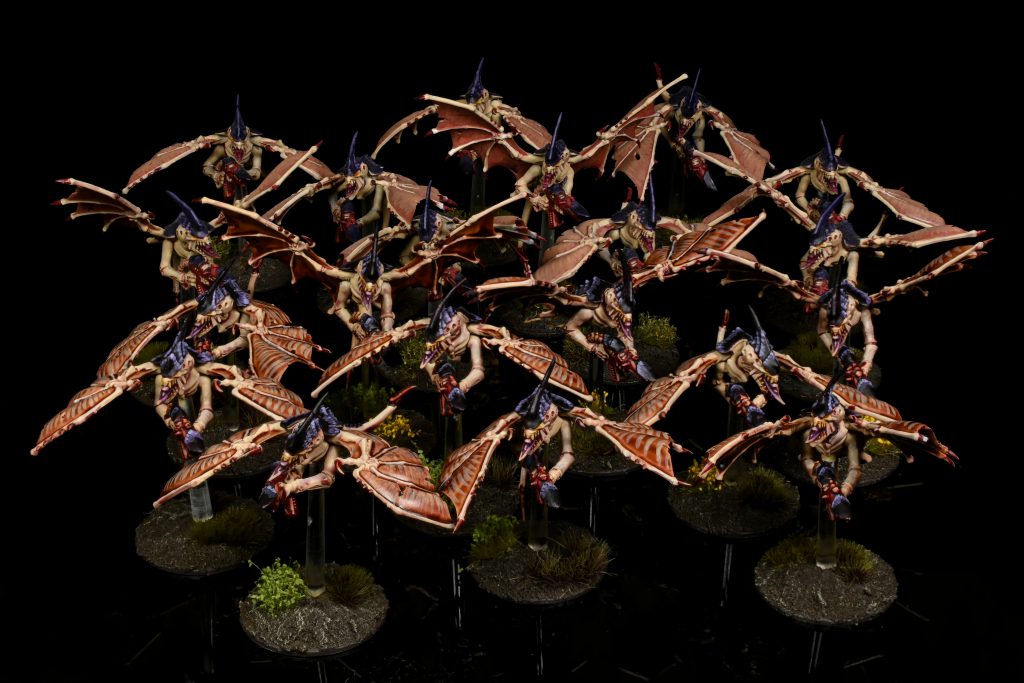
Elites
Toxicrene
As much as we want to like them, these venomous monstrosities don’t fulfill a necessary competitive roll. They’re somewhat tough but lack a natural invulnerable save and their primary damage output is -2AP 1D which even with 12A is pretty underwhelming. Its ideal targets are things like Orks Boyz or Necron Immortals, but in these cases it’s going to kill a quarter of its value and then likely die a horrible death. That’s against an ideal target, mind you. They do have a neat gimmick Stratagem in Toxic Entanglement, but ultimately that only makes it more sad when they warm the bench.
Tyrant Guard
If you’re bringing any flavor of HIVE TYRANT, these are near mandatory these days. Allowing those HQs to benefit from Look Out, Sir offers a primary defense against first turn strikes that would otherwise leave your precious monster a smouldering crater. They’re nothing to write home about in terms of offensive capability (though they’re not nothing), but for the 40pts per model their ability to soak damage is worth the cost of admission. Unless you have the spare points, it’s probably best to leave off upgrades here and any of their weapon flavours are fine. They exist primarily to hide/tank your leader-beasts and if they do that alone they have succeeded.
Lictor
Another unit that got a huge glow-up from its previous iterations, the Lictor is now an actual threat to models in close combat. With its speed, deployment options, and defensive buffs there’s actually a good chance it’s actually going to make it into combat. The trouble being that aside from a distraction or potential assassin for minor characters it’s a touch overcosted and competes with a huge number of good Elite choices. If Cranial Feasting sounds like a good secondary to pursue they’re not necessarily a terrible idea, but players aware of their threat are going to wrap choice targets when possible. Competitively this role is likely played by Deathleaper, who’s slightly tougher and as CHARACTER can host WLTs and Relics.
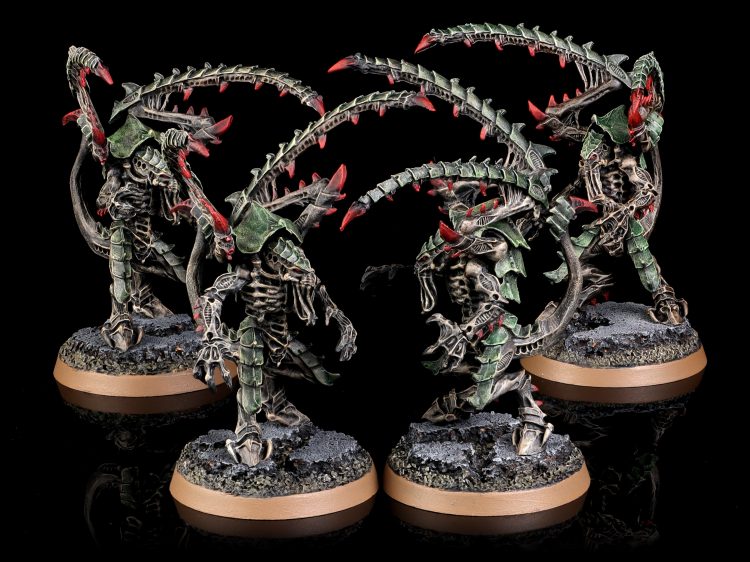
Credit: Pendulin
Deathleaper
For less than half the cost of two Lictors, you’re getting a CHARACTER with more wounds, more attacks, a better save, and a few fancy abilities that can put a damper on your opponents plans. Combined with Alien Cunning, Deathleaper has the offensive capability to tear off a few enemy models from a mid-sized unit and claim an objective for itself (and when necessary slip back into the shadows afterward). With the disappearance of Stranglehold in Nephilim, this particular act has lessened in value a bit but it’s still nice to have combined with the chance for Cranial Feasting to pay off.
Maleceptor
Even after a number of necessary targeted nerfs here, the Maleceptor still stands as one of the best models the Tyranid codex has to offer. Capable of manifesting two psychic powers and denying one, it also has the Encephalic Diffusion Psychic Action which reduces incoming range damage by 1 to all units within 6″ Aura. This can be helpful on the approach, especially if you pull first turn and combined with the multitude of other defensive buffs the Tyranid army has makes denting your beasts a real headache. Its Synaptic Imperative Psychic Oversight allows units to make a Psychic Action and still manifest powers (though the Action does count toward the unit limit); this is only going to be benefit Maleceptors unless you opt for a Warpcraft secondary.
Post-nerf its limited to two possible Psychic tests to trigger the Psychic Overload ability but this is still a huge threat when applied properly. In a vacuum pushing 6+ mortals is amazing, but it can take some maneuvering and wise opponents will shove forward sacrificial units to avoid taking damage on priority targets. These are a known threat through the competitive world, so expect it will take some effort to really make these shine.
The Maleceptor is great under any circumstance but its a real standout when combined with applications of a Neurothropes Warp Siphon to force through as many Psychic test rolls of 7+ as you can.
Pyrovores
If you’d have told us prior to this edition that you were fielding Pyrovores we likely would have balked. Now, Pyrovores are a major threat at range with their flamespurt weapons and are capable of respectable melee damage to boot. As INFANTRY, these models are comfortable hanging back on objectives and performing Actions (primarily Raise Banners) and acting as a deterrent for your deployment zone. Alternatively, you can load up to six (two units of three) into a Tyrannocyte to deliver them into the sweet spot to dole out strong anti-infantry fire. Good to have around, though in the real-world they can be tough to find and cost-per-point are very pricey.
Haruspex
There’s not a lot to say here. The Haruspex contends with a high-demand slot and fills a melee damage role that can be taken by a number of other units. They are dangerous to be sure and its possible that certain lists can make them work to satisfaction. They have a large enough footprint that some factions will be able to move-block them as a delay tactic. They have a few nice bits, such as natural ACID BLOOD and HORNED CHITIN, and the grasping tongue attack is cute, though one D3 attack that ignores Look Out, Sir is probably not enough to down a Character unless they were going to die soon anyway. If you’re going to give it a go, you’ll probably want to plunk down the extra points for Dermic Symbiosis.
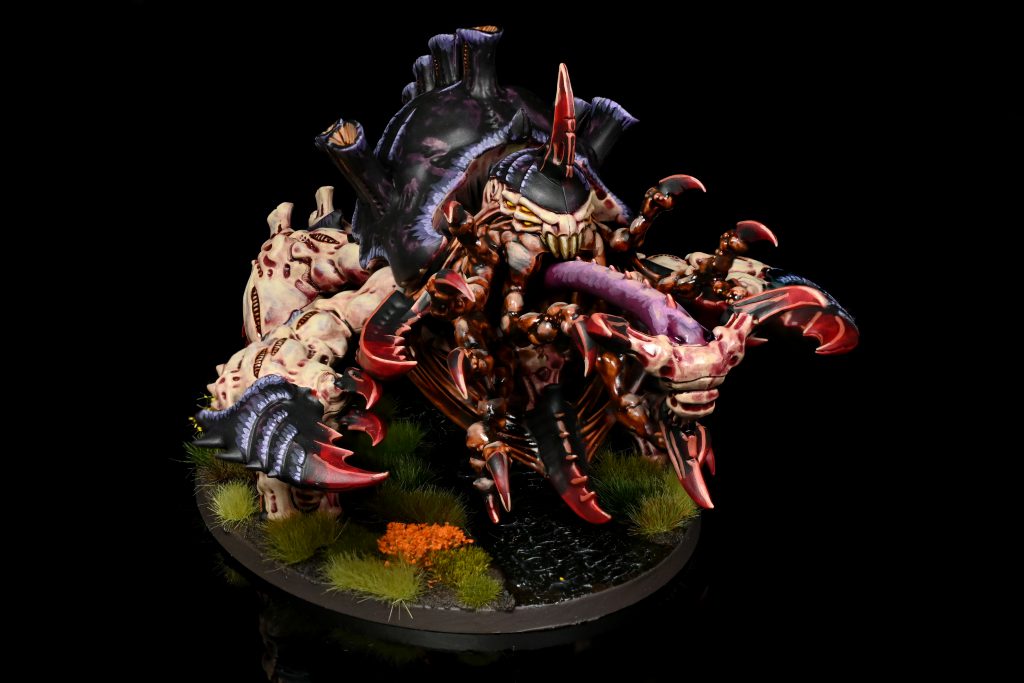
Venomthropes
It’s pretty obvious that forcing a -1 hit modifier across a huge swathe of your army is a good thing, which is why Venomthropes are now a common sight in competitive lists. In 9th edition these are durable at T5 W4, meaning even if they’re out in the open your opponent is going to have to focus some of their stronger firepower into the unit to take it out entirely. You’re likely going to take best advantage of their spore cloud in the early rounds. As your army spreads in different directions as the battle goes on, if heavy firepower goes into these instead of your more dangerous models then they have served their purpose well.
If they do survive the approach Venomthropes are not all that bad in combat and will be comfortable taking chunks out of infantry of any kind, as their poison lashes wound any non-VEHICLE/TITANIC model on a 2+. Better still if you’re engaged with a non-MONSTER/VEHICLE unit and it attempts to Fall Back you can force it to Remain Stationary instead on a 4+ roll. Considering that’s not a strat but a baked-in ability, it’s a neat perk. Venomthropes also have the honour of being one of the few sources of Fight Last in the codex, able to be used both offensively and defensively on a 3+. Don’t bet the house on either of these abilities, but getting them off when needed is going to ruin some plans.
Zoanthropes
As mentioned above in the Warp Shielding entry, Zoanthropes are almost mandatory in every competitive Tyranid list. Come for the Synaptic Imperative, stay for the easily-achievable “super” Smites! The Warp Blast ability improves your Psychic test result for any Witchfire power or Smite, adding +1 for every Zoanthrope model in the unit (up to +3). Better still, the mortal wounds inflicted by the unit are increased by one for every remaining model (up to 3 again). As the magic number here is three you’re mostly going to see MSU here, extra models are only going to help you keep your bonus topped off if you start losing models. One unit is usually enough, but doubling up on them might be worthwhile if you want to put emphasis pushing mortal wounds (if you do be sure you have a Neurothrope with Synaptic Tendrils around to grant Warp Siphon to both).
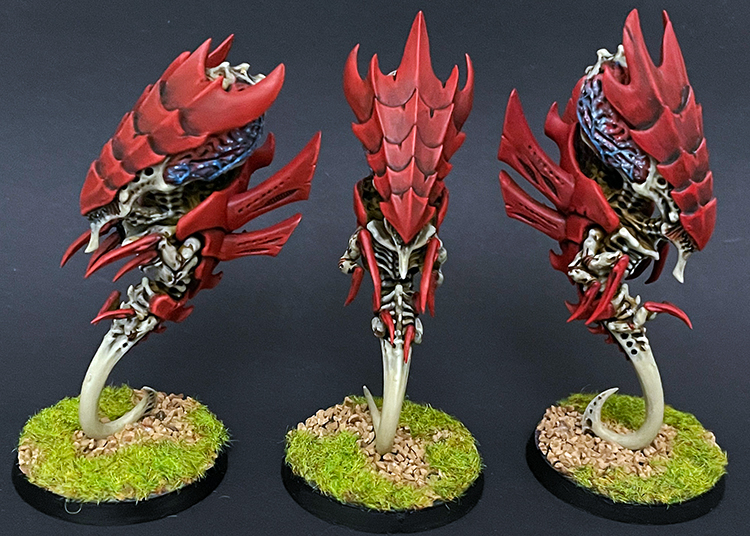
Genestealers
Tyranid Genestealers are in a bit of a weird place right now. They’re no longer Troops, instead being an Elite (but still CORE) vanguard unit that can forward deploy. This new version has lost their classic ability to Advance and still declare a charge, making them a much better imminent distraction for an enemy. In the perfect circumstances Genestealers might work out for posting on objectives or behind Obscuring cover waiting to make a first turn charge, but if you pull second it’s a relatively expensive and squishy unit that’s going to vanish if they get a bead drawn on them. Their infestation node is an interesting idea, but you’re paying points for a chance to deploy more Genestealers and if an enemy gets even vaguely nearby it disappears so you’re just inviting disappointment. Competitively we haven’t seen much movement on these, and that’s likely because they’re just too heavy an investment for the return.
Fast Attack
Raveners
Essentially Tyranid Warriors that swapped out their brains for a tough serpentine body, Raveners offer some hefty anti-infantry power that can be delivered to your targets quickly and safely. As a BURROWER unit, these models can opt to come on from Strategic Reserves via Death From Below without having to pay CP for the luxury. Much like Warriors, these are best equipped with deathspitters. Post-nerfs a number of lists had to make some cost-cutting considerations so we’ve seen less of these lately but they’re still quite useful when applied correctly.
Ripper Swarms
Now an Fast Attack choice, Ripper Swarms took a bit of a cost hike and consume an FA slot without actually fulfilling any detachment requirements which is an interesting design choice. If you have the spare points and can’t think of much else to bring along*, they’re not bad for dropping on an objective to play babysitter and check the box for Engage On All Fronts. They’re still incredibly meek, so assume that’s all they’re doing unless they can comically gnaw on the treads of a tank and keep it from shooting better targets. Even if you don’t pay the points for them if you’re fielding a Parasite of Mortrex you will want to have some bases of these handy during play.
*Forgeworld Sky-slasher Swarms are the same cost and just straight-up better value. If you want to spend for some rippers and have the model that’s a better buy.
Parasite of Mortrex
A 5th edition weirdo has returned triumphant with a cool new model and rules. The Parasite (which is not UNIQUE, by the way, you can take multiple if you want) is a very fast skirmisher with a special ability that makes it ideal for wrecking your opponents plans. Aside from its general combat skills, this model is a good source of mortal wounds on anything non-VEHICLE. If an enemy unit gets too close, a Parasite can perform a fly-over Enfolding Strike and then charge in for hits including its barbed ovipositor. It’s not a sure bet on either, as the strat works on a 2+ and you need to successfully wound with its weapon (though at WS2+ and S6+ that’s not impossible), but if you manage it that’s 2d3+1 mortals before the opponents next Movement phase.
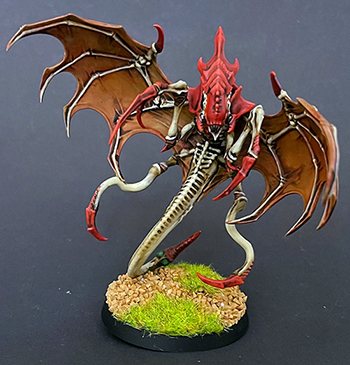
Thanks to its speed and ability to redeploy and re-roll charges via Encircle The Prey this is an ideal model to give the Alien Cunning WLT so it can bully some enemy units off objectives. Bear in mind if the Parasite infects the enemy unit it loses Objective Secured, so you could be charging a 30-model ObSec unit on an objective and so long as you toe-in to the space and wound with the ovipositor (and live, let’s not forget that), you’ve successfully stolen that point at least until their next Command phase. Worst case you kill any banner, best case they keep itching and you deny them the point for primary.
Mawloc
This model is point-cheap for what it can accomplish in the right circumstances. Players may get hung up on the Terror from the Deep ability that (similar to other Orbital Bombardment-like rules) places a marker and promises pain for any enemy units that are within range at the start of your next Movement phase. This ability can be good to deter your opponent from a location, but a lot of players are going to just accept this as the cost of play and move on. This is neat, but unless you start the ball rolling on the first turn doing this ties your monster up off-table for another turn and against enemy units smaller than five models it’s going to fail a third of the time anyway. If you really want to force mortals onto an enemy unit, get this into combat where its Distensible Jaws ability can put in some work.
16 attacks plus a tail weapon is going to put in a lot of wounds, but a Mawlocs scything talons limited armour penetration and damage means it’s best applied to weak infantry. In addition to its large block-able footprint, the Mawloc has no invulnerable save. It is priced reasonably well and just under the 3VP cut for Bring It Down at 14W. There’s a lot of other multipurpose anti-infantry available to Tyranids and with points so tight dedicated models like the Mawlocs aren’t going to find much use.
Trygon
Very similar to Mawlocs, Trygons have a ton of attacks that are great for slashing through non-elite infantry. Its armour penetration and damage are higher in exchange for reduced attacks, which is… fine. Again, this is expensive enough that you’re probably going to put your points into either more efficient monsters or more flexible units.
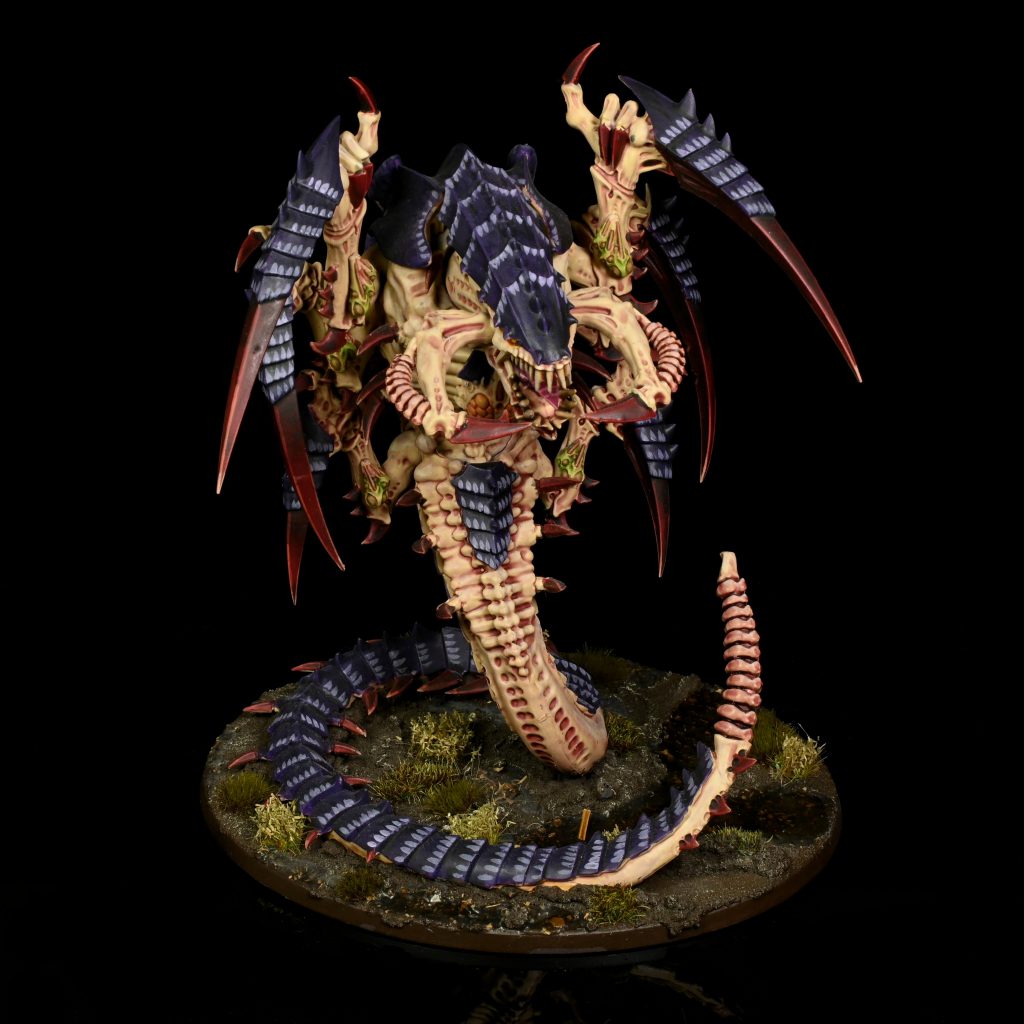
Mucolid Spores
These giant spore mines are quite potent if you can get them within range of an enemy model to detonate. At their point cost, it’s likely you’re going to avoid paying for these outright and instead spawn them from a Sporocyst if you want to go with that fun spore skew. Even if you are capable of spawning them, it’s likely you’re going to go with six Spore Mines instead as its a more reliable source of mortals. The d3+3 spike damage looks appealing, but consider that averaged out a Mucolid inflicts 3 mortals and six Spore Mines will inflict 8.
Spore Mines
Even if you’re not paying into these for units to deploy or drop in via Float Down, you’ll want to have a bunch on hand if you’re fielding Biovores, Harpies, or Sporocysts. Considering the Tyranid army list is points-starved, even at their low cost you’re probably going to want to avoid buying them and instead spawn them for free with the units listed above. These little fellas are not to be taken lightly; they can pack a mean punch if they get within 3″ of enemy models. You opponent would be wise to avoid or destroy these instead of barreling into their midst and if they have some spend some extra movement or shooting actions to do this the Spore Mines have already paid for themselves.
Meiotic Spores (Forgeworld)
A weird mix of normal Spore Mines and Mucolid Spores, Meiotic Spores deal moderate damage but are slower at 3″ and must be purchased in a unit of at least three models. Give this one a pass.
Sky-slasher Swarms (Forgeworld)
The winged cousins of Ripper Swarms, translating from 8th edition to 9th edition their cost in the Forgeworld rules have remained unchanged which means they’re the same price as regular ol’ Rippers. What do you get for that? Well, you get a unit that can fulfill a Fast Attack detachment role and can FLY up 12″. So just plain better. If you want a unit or two to drop in for objective-snatching or cheap Engage On All Fronts this is the better buy (provided you can find the models).
Dimachaeron (Forgeworld)
The terror of early 9th Edition thanks to the Imperial Armour Compendium, the Dimachaeron lived and died on the old 8th Edition Swarmlords ability to allow it to move twice in a turn. Now that it can’t (let’s be clear, most of us are glad this has gone away), the Dimachaeron is looking a little rough for its cost. There is a lot to like here; it’s fast, tough, and has a very high damage output, but without shooting across the table like a bullet your opponent is going to have enough time to try to clear it before it wrecks priority targets. There are a number of Hive Fleets where this could work–Leviathan with the Synaptic Enhancement Adaptive Physiology to access Synaptic Control or Kraken to use Opportunistic Advance and Onslaught to get close to its old land-speed record are probably the best bets. You could also opt to bestow Dermic Symbiosis, but paying a premium for a bump from 5++ to 4++ stings. Forgeworld models have not received any point balance adjustments and this thing is still costed like the nightmare of old. Until this gets a revision, it’s probably best to give it a pass.
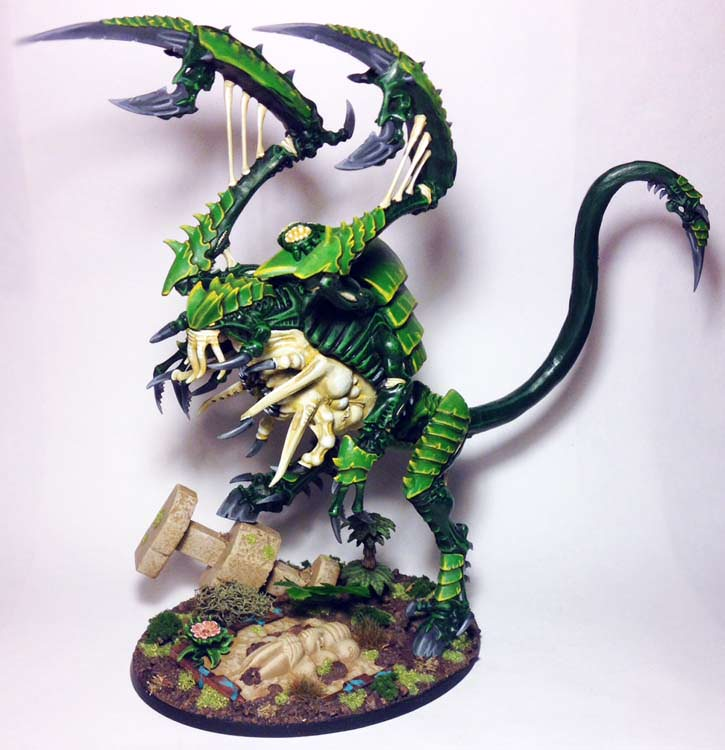
Heavy Support
Exocrine
Exocrines have been a solid pick across multiple editions and this remains true. These gun-beasts have a strong anti-elite gun, putting out a respectable 6+d3 S9 AP-4 D3 Blast shots which ignore the benefits of cover if they don’t move too far. Even if they do, a quick application of the Observer Organism strat will bring that back and tack on exploding hits on 6s. They are expensive, but score solid hits into elite units and they quickly pay for themselves. A big Achilles heel here is these models cannot fire in close combat, so if your opponent gets into Engagement Range you’re just out a heavy gun for at least a turn. Be mindful of this during deployment and make sure they are defended accordingly.
Biovores
Tyranids are mortal wound-generating biomachines and Biovores are another good source for these. The models spore mine launcher can be used to fire at an enemy unit directly, but they have poor BS and are probably better applied toward spawning Spore Mines at range to provide dangerous blockers for an opponents next turn. Creating d3 mines per model is pretty great; keep your Biovores hidden behind terrain and after three turns of spawning on average you’re going to have paid their points costs in mines created. One trick to note here is that you can start the action to Spawn Spores, resolve the rest of your shooting phase and choose to break the action at the end if you need a mortal or two to finish off a kill.
Carnifexes
The noble Carnifex returns, emboldened with a very durable body and high-powered weaponry. This model kit remains the most variable of any other Tyranid, allowing you to create a wide variety of combinations. Competitively you’re most likely to see Carnifex outfitted with adrenal glands, enhanced senses, either scything talons or crushing claws, and heavy venom cannons to make it a double threat. Provided you have the points for it, spore cysts are going to be a good investment for most matchups; pushing their save to 1+ means that incidental shooting is not going to make a dent and your opponent will need to really focus fire. They’re okay as a one-off model, but Carnifex really benefit from a stampede of them to force hard target priority choices. If you’re looking for a melee-only version, it’s probably best left to the Screamer-Killer.
Screamer-Killers
A faster, louder CARNIFEX, Screamer-Killers are brutal anti-elite models that can also force worse Morale tests to clear additional models. There’s not much to discuss here as their unit concept is without nuance: run at a target, charge the target, murder, repeat. Adrenal glands are a must here and like its shootier brethren spore cysts are a nice-to-have. Competitively these can fill the anti-elite roll and unless they have enough horde models to swamp your monster they’re going to give them a wide birth. Going into T8 these are not ideal, but as a CORE entry there’s a number of ways to improve your hit rolls and Voracious Appetite can help level the odds provided its not already going to a better target that phase.
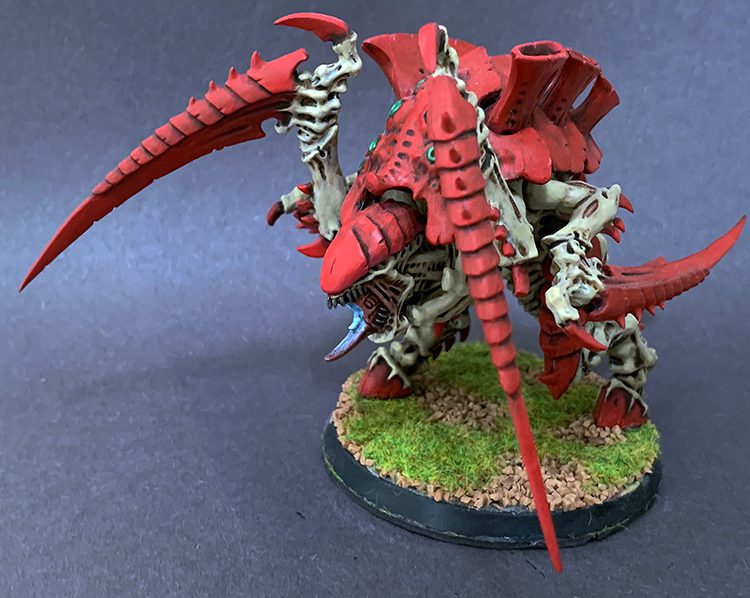
Thornbacks
This is a bit of a muddled unit entry and competitively is not going to see much play. A CARNIFEX that has slightly better shooting rules and and slightly better melee rules at a slightly higher cost. Competitive Tyranid lists are looking to squeeze as much out of every unit as they can and the benefits here are not enough for the modest point tax.
Hive Guard
As you’re likely aware if you’ve been playing 40K for any length of time, these models were the most popular Tyranid choice in 8th and early 9th Edition. Their latest incarnation has taken a pretty rough beating, knocking down their impaler cannon stats from long-range anti-elite/tank to a mid-range mid-strength gun. Their Defensive Stance Action is a weird one, as they’re not Objective Secured or CORE so it’s useful in very few circumstances. There’s some argument that either gun might be useful against units that incur hit penalties, such as Aircraft, as Synaptic Guidance is simple enough to access, but at their price it’s likely better to invest in one of the faster or more powerful ranged monsters available.
Tyrannofex
An extremely tough weapons platform, the Tyrannofex can be kitted out as either anti-infantry or anti-tank. Both options have some play but the most competitively popular by far is going to be the acid spray option, as D2 hits at range are a big threat to the numerous W2 models out there. The rupture cannon option is high risk/high reward and might not be the type of gamble you’d want to take in high-stakes play. If you do, it is likely best as Leviathan where the free hit re-roll is going to help mitigate poor results.
Stone-crusher Carnifex (Forgeworld)
This was a questionable entry when it first hit and now has become a weird and bad choice compared to any other CARNIFEX variant from the main codex. Less durable and only available as a single model, the Heavy Support slot is in-demand and I don’t think there’s any way to justify this in a competitive list.
Barbed Hierodule (Forgeworld)
This is one of the models that took full advantage of the 8th Edition’s Pathogenic Slime which increased the damage characteristic of ranged attacks for a MONSTER by 1. Now that that’s out the window there’s a little less value here, although it’s still no slouch at force-feeding D2 wounds onto prime targets. As one might imagine for a giant shooting bug, this is best as in the Kronos Hive Fleet where it can take full advantage of Symbiostorm for +1S to wound T8 on 3+. More difficult to hide due to being W18, its a touch overcosted and it may be worth considering taking an Exocrine instead where you’re getting D3 shots.
Scythed Hierodule (Forgeworld)
The Scythed Hierodule has remained pretty popular since its rules update and it’s the competitive Forgeworld monster that was affected the least coming into 9th Edition. A good offensive forward-deploy, scything talons hitting at S10 will wound anything on the table at 3+ for some major damage, while its acid spray is very handy for hosing down screaming infantry and with Overwatch makes it a real hazard to assault without any kind of gameplan. There are a number of abilities and stratagems from the various Hive Fleets that play well into this, but at a 12″ move it’s probably most comfortable in Kraken where it can boost to a blazing 20″ and charge in combination with Onslaught. The added AP trait also helps to make sure those bit hits cut through armour. This is a good model to invest Dermic Symbiosis, as the 4++ onto this T8 platform is a huge bump in durability.
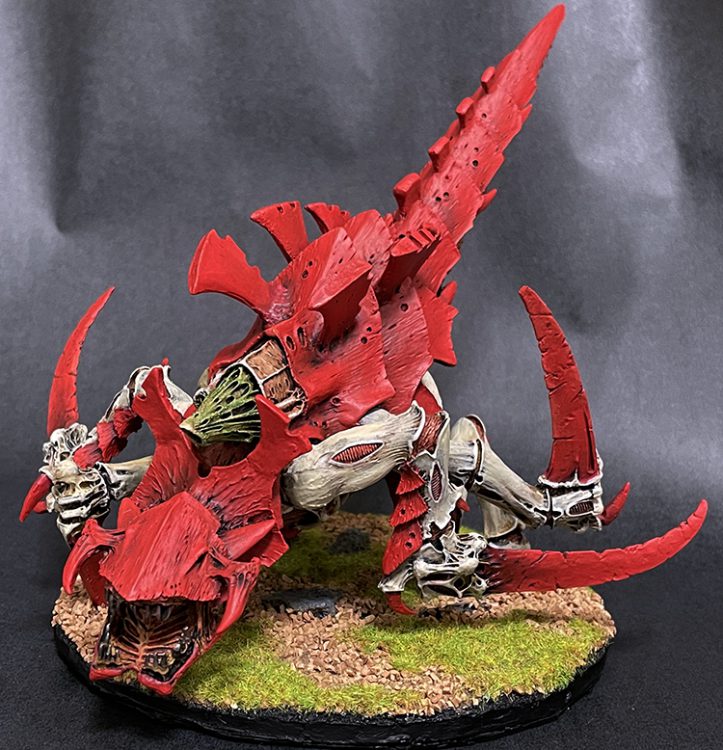
Dedicated Transports
Tyrannocyte
Tyranids finally have a drop pod, folks, and it’s hungry for blood. Capable of arriving at any turn, regardless of match type, this giant flesh bulb is a great candidate for delivering heavy hitting models to the right location quickly. There’s a number of great candidates to ride in this thing, the most popular of which right now is probably units of Pyrovores. Similar to the heavy-weapon marines coming down in a pod, they have the shooting to really put a hurt on a number of targets and are enough of a threat to distract from other incoming units. The Tyrannocyte is a little pricey and offensively very swingy thanks to its numerous attacks and poor WS/BS, but at T7 and 15W it has some staying power to roam the table and cause problems if your opponent doesn’t have the time or resources to put it down. Aside from the point cost, you should consider whether handing out 3VP for Bring It Down is going to be worth it. If you’re running a horde list and don’t have enough other MONSTER models to make it worthwhile you’re probably fine, and likewise if you’re flooding the zone with W10-15+ models it’s likely that you’ve accepted they’re maxing it anyway.
Flyers
Hive Crone
For its role this model is actually rather good, but completely overshadowed by its counterpart the Harpy and probably isn’t going to see the table anytime soon. The Crone provides some decent mid-range anti-infantry shooting and is a special threat to models with FLY, hitting at 2+ and able to assault across the board. Bonuses to VEHICLE and FLYER models are also nice, but at the end of the day they’re just not going to outperform the shooting found elsewhere.
Harpy
Even after a heavy points bump, the Harpy reigns supreme as one of the best FLYER models in the game. While the obvious draw is its fantastic shooting profile, players will quickly realize that its potential for mortal wound spam and Spore Mine placement gives a huge tactical edge that’s not found elsewhere. This is typically equipped with two heavy venom cannons, though if the rest of your list is covering heavy shooting there’s an argument for taking the anti-infantry stranglethorn cannons at a discount. A common setup is taking two Harpies and giving one of them Synaptic Enhancement to grant Warp Shielding to itself and its twin during games where you take first turn and aren’t going to have other SYNAPSE models in range. There’s not many competitive people who don’t know the terror of these things by now, but those that do will quickly learn. Expect them to be a high target priority; if you have the luxury of limiting your opponents attacks against them, use their movement to your advantage and measure out where they will be safest.
Fortification
Sporocyst
We haven’t really seen any movement on this thing competitively, and that’s… fine. It’s not particularly effective in shooting or close combat, but its ability to pump out Spore Mines can quickly become a problem if your opponent is not paying attention. Depending on the table and the matchup it can be useful for move-blocking, though place it in the wrong spot and it’s just going to act as a sling-shot for their strong melee units. If this thing survives two turns and spawns twelve mines it’s already paid for itself, but it’s not often taken competitively because its immediate damage capability is very low (you can’t even hurl spawn mines into an enemy unit the turn they arrive) and there’s not many plays you could make with it that can’t be done another way better.
Lord of War
At the tail-end of their 8th Edition rules, both of these Lord of War models got a bit of a revival thanks to Crusher Stampede. Unfortunately in 9th Edition they suffer from some targeted rules excluding TITANIC models from upgrades and powers that would make them a much more competitive choice. Some of the Hive Fleets do offer some interesting interactions, so there might still be some potential here, but there have not been a significant number of competitive lists featuring these huge investments.
Harridan (Forgeworld)
The giant terror of the skies, the Harridan offers you a very fast ranged weapons platform with some options for passengers. This model is pretty straight-forward: it’s a method to aggressively push into an enemy’s line while shooting, drop into Hover mode, dump out a unit or two of Gargoyles, and then assault a choice target with powerful talons. Alternatively, you could opt to hang back and fire from afar, but with no invulnerable save (outside of a round of Warp Shielding with proper positioning) it’s not going to last long if your matchup has any good long range anti-tank worth mentioning and you’re ignoring half the power of the model. With Gargoyles getting a huge facelift this edition, acting as a secure drop-off method for scoring backline objectives avoids the potential for your opponent to screen out units coming in off-table. Ultimately the cost (real-world money and points) of the model is the big problem here. Most players will decide to spend their resources on more units to diffuse target priority and improve their tactical flexibility on the table.
Hierophant (Forgeworld)
The mighty Hierophant is something we want to love. It’s an offensive powerhouse, but 9th Edition factions are capable of a ton of targeted damage output and 34W disappears pretty quickly with limited movement and damage mitigation. Its ability to carry 20 INFANTRY models might offer some option for tricks, but its best left to non-competitive games.

How They Play
Modern Tyranids have the potential to excel in almost every phase, and competitively it’s recommended you plan your list around this concept. All of the strong units are good enough to just brute force a win in many circumstances, but you’ll find that top players bring other tools along with them to play better to the mission. Leaning too hard into Nidzilla territory means secondaries are more difficult, but leaning too hard into the horde can mean you don’t have damage output necessary to clear important targets. In the end, it’s all about proper balance.
In terms of supplemental units, there are some standard picks that aren’t going to be killy, but are going to be a pain for your opponent and score you the points you need. Lictors (primarily Deathleaper) and a Parasite of Mortex are often employed for bullying enemy units off objectives. The Tyranid faction suffers a tad from secondary objective selection, especially if you were to only field MONSTERS, so Termagants, Hormagaunts, or Gargoyles are often brought along for secondary objective management. Unless you have a specific plan, it’s best to hide these units when possible; a good opponent is going to understand clearing out your Troops is the key to denying you the chance to run away with secondary VP.
Aside from bugs being fast, the Movement phase offers tactical flexibility. The ability to take units on and off the table units can be key to strong positioning or surprise charges and if played right this can be difficult for your opponent to deal with in addition to pressure from your main force. The phase can also be made dangerous with the addition of a Harpy or two. Dropping mortal wounds onto large blocks of infantry or units of vehicles (such as Mephitic Blighthaulers) is generally the best option, but looking to knock wounds off of a model that limits wounds in a phase (such as C’tan) or drop Spore Mines onto the table to hinder movement or threaten mortals next turn is a fine pick as well.
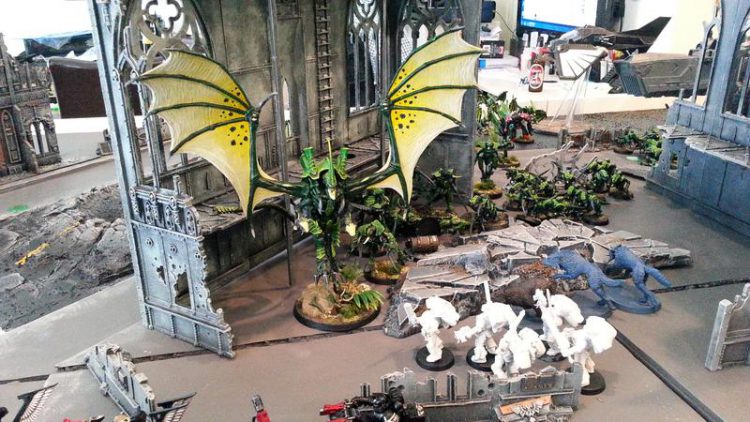
It’s not uncommon for the Tyranid to be the psychically dominant faction on the table. This can be used to a significant advantage, especially in combination with Synaptic Link. Learning to plan movement around this rule is critical, as it allows you to access your powers when and where you need them and potentially deny your opponent the chance to stop you. More general to the game itself, proper positioning and distance for “closest enemy unit” powers is key if you really want those mortals going into prime targets. It can be important to understand how applying your units to combat is going to impact your ability to manifest powers, especially if you plan to Fall Back for any reason. Remember–falling back means no psychic tests from that unit for the turn. In an emergency, you can use Synaptic Channeling to apply a power you might need to another psyker.
Unless you’re going with a melee-only gimmick army, it’s best to consider ranged options to combat infantry, elites, and tanks. A major benefit to the faction is all of their major ranged weapons (excepting the rupture cannon) have a static damage profile which allows you to more reliably plan how much to commit to any given target. Beyond the unit entries, there’s not a huge amount of faction-specific information for tactics here: shoot priority targets, clear blocking chaff when necessary. Noted above, but be sure to keep Share Lure in mind, reserving at least a few ranged attacks from a SYNAPSE model to tag an enemy unit you need to charge.
Aside from their dedicated gun-beasts, both Tyranid elite infantry and MONSTER models have a healthy mix of threat type, which makes understanding positioning and distance important for charging/counter-charging. Remember to generously apply Trampling Charge when possible; against hard targets pushing a good number of mortals for 1CP is a steal. In addition to normal Fight phase movement, when possible plan around ways to leverage any improved Pile In or Consolidation movement distance. That extra speed can be a means to flood a pathway, tag an objective, and/or additional enemy units. It’s something that’s available to other factions, but it can still be a clutch tactic in the right situation.
Finally, it doesn’t come up incredibly often, but manipulating enemy Leadership and Combat Attrition rolls for the Morale phase can be hugely powerful if you’re trying to break large blocks of infantry (keep in mind that these are applied in the Psychic phase and Fight phase, respectively). In the current meta this doesn’t come off super often, but doubling up on The Horror and Psychotropic Venom can push units to roll on a -4 modifier and lose half of their remaining unit on a failure. For example, a block of Necron Warriors taking losses in any non-Shooting or Fight phase is especially damaging and it only takes losing a few models before failing their morale check is a real possibility.
Lists
As you’ve likely gathered from the lengthy review above, there are a multitude of different Tyranid list variations you can try. Most units are strong enough to put up a fight if you just want to slap together your favorite bugs, but in order to get the most out of your army competitively you’ll want to make sure you have your different options covered.
PierreTheMime’s Monstrous Utility List
Battalion detachment, Hive Fleet: Kraken, Adaptive trait: Augmented Ferocity
HQ: Swarmlord (Power: Paroxysm, Power: Psychic Scream) 240pts
HQ: Neurothrope (Power: Catalyst, Power: Onslaught, WLT: One Step Ahead) 100pts, -1CP
Troop: 5x Tyranid Warrior (Adrenal Glands, Flesh Hooks, 5x Bonesword and Lashwhip, 4x Deathspitter, Venom Cannon) 175pts
Troop: 5x Tyranid Warrior (Adrenal Glands, Flesh Hooks, 5x Bonesword and Lashwhip, 4x Deathspitter, Venom Cannon) 175pts
Troop: 10x Gargoyle 80pts
Troop: 10x Gargoyle 80pts
Elite: 3x Tyrant Guard (Bonecleaver and Lashwhip, Rending Claws) 120pts
Elite: 3x Venomthrope 105pts
Elite: 3x Zoanthrope (Power: Neuroparasite) 150pts
Fast Attack: Parasite of Mortrex (WLT: Alien Cunning) 80pts, -1CP
Heavy Support: Scythed Hierodule (Adaptive Physiology: Dermic Symbiosis) 260pts
Flyer: Harpy (2x Heavy Venom Cannon, Adaptive Physiology: Synaptic Enhancement) 215pts
Flyer: Harpy (2x Heavy Venom Cannon, Adaptive Physiology: Voracious Ammunition) 220pts
Total: 2000pts, 4CP

The primary plan here is to castle deploy, hiding the Venomthropes and creating a base of operations to place everything else within their clouds. If going first, the Harpies move as a team so they can benefit from Warp Shielding and if going second the enemy can deal with a -2 hit modifier which should offset a lot of anti-flyer bonuses. Using the Harpies and the Scythed Hierodule, this list can put a ton of forward aggression onto armies that can’t handle it, but is also comfortable hanging back and drawing the enemy in. Gargoyles can move to capture quarters for Engage/Retrieve X Data, potentially flying off the table afterward to go score in an enemy quarter next turn (Encircle isn’t as useful as it used to be, but it’s still great for actions that complete at the end of the Movement phase). The Swarmlord uses its abilities to bump up a Tyranid Warrior unit for full rerolls and assert control over objectives, moving into position to best support the midfield with its guard.
This list takes a couple of picks that are a bit off the beaten path, mostly in leveraging Swarmlord as a support/counterpunch center. I’m a fan of utility characters, this saves me 2CP from your typical Reaper Flyrant, and you can’t really say no to 9 bonesword attacks in a pinch. This particular list plays to my style and affords a good deal of flexibility while still giving me most of the strengths of the best units available. I had 10 extra points to spend, so those went into flesh hooks for both the Warrior blocks–you never know when a +1 hit mod is going to come in handy.
Innes Wilson’s Leviathan Warrior Bricks
Battalion detachment, Hive Fleet: Leviathan, Adaptive trait: Augmented Ferocity
HQ: Winged Hive Tyrant (Adrenal Glands, Power: Psychic Scream, Power: Onslaught, WLT: Adaptive Biology, Relic: Reaper of Obliterax) 225pts, -2CP
HQ: Neurothrope (Power: Onslaught, Power: Catalyst, Power: Paroxysm, WLT: Synaptic Tendrils, Relic: The Resonance Barb) 100pts, -2CP
HQ: Broodlord (Power: Neuroparasite, WLT: Direct Guidance) 120pts, -1CP
Troop: 9x Tyranid Warrior (Adrenal Glands, Flesh Hooks, 9x Dual Bonesword, 3x Barbed Strangler, 3x Deathspitter, 3x Venom Cannon) 320pts
Troop: 9x Tyranid Warrior (Adrenal Glands, Flesh Hooks, 9x Dual Bonesword, 3x Barbed Strangler, 3x Deathspitter, 3x Venom Cannon) 320pts
Troop: 10x Gargoyle 80pts
Elite: 3x Tyrant Guard (Adrenal Glands) 135pts
Elite: 3x Venomthrope 105pts
Elite: 3x Zoanthrope (Power: Neuroparasite) 150pts
Flyer: Harpy (2x Heavy Venom Cannon, Adaptive Physiology: Synaptic Enhancement) 215pts
Flyer: Harpy (2x Heavy Venom Cannon, Adaptive Physiology: Dermic Symbiosis) 230pts
Total: 2000pts, 1CP
This list looks to leverage the most of the durability buffs available to Tyranids with both the Zoanthrope Warp Shielding Imperative and Leviathan’s Synaptic Control trait to make big squads of Tyranid Warriors about as close to unkillable as the game allows while also buffing them for high damage at both shooting and combat. Two Harpies provide fast shooting to complement the ranged output of the main squads and the Reaper Flyrant makes its omnipresent return.
The standard defensive utility pieces of Tyrant Guard, Zoanthropes, and Venomthropes round out the list along with a Broodlord and Neurothrope to hold down the fort with buffs, psychic powers (and Psychic Interrogation options), while also allowing the list some forward deploy which is crucial to ensure the list has the requisite 2CP for Reinforced Hive Node when it goes second in Recover the Relics from the Nephilim pack.
Conclusion
The 9th Edition Tyranid codex is what Tyranid players have been awaiting for a long time. It’s strong, interesting, and fun! Thanks to most unit entries being good on their own, almost any list can be made into a force to be reckoned with and those looking to hone a competitive army will find a lot to love here. Get an idea of how you want to play, get your models sorted, and prepare for a feast!
Tyranids’s is back baby. It’s good again. Awoouu (ripper Howl)
Have any questions or feedback? Drop us a note in the comments below or email us at contact@goonhammer.com. Or if you’re a patron, head on over to our Discord and chat with us!
